Barron's SAT, 26th edition (2012)
Part 4. TEST YOURSELF
Chapter 10. Five Model SAT Tests
Model Test 2
Answer Sheet—Test 2
Section 1 ESSAY


Section 2

Section 3

Section 4

Section 6

Section 7
![]()
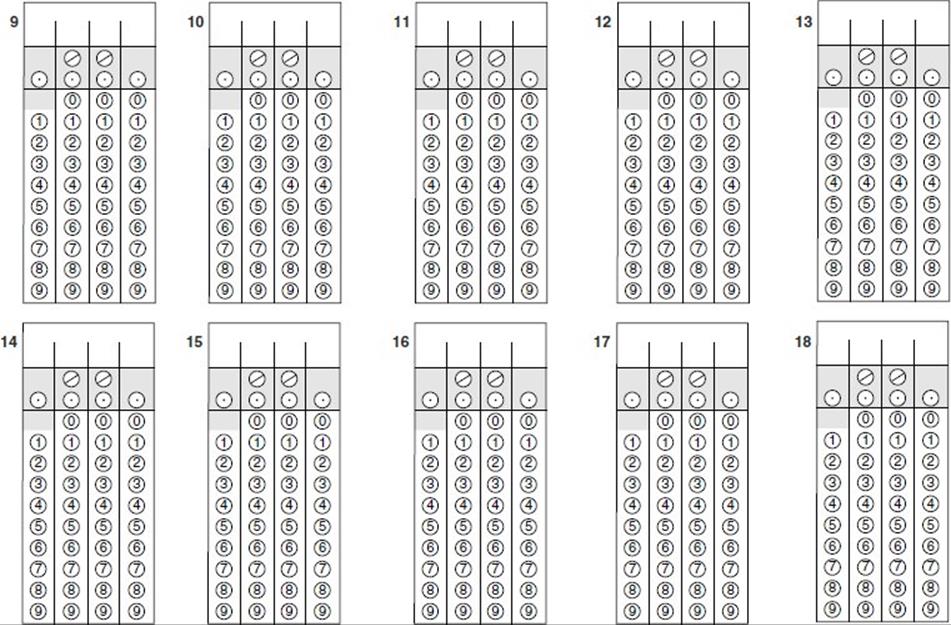
Section 8

Section 9

Section 10

Test 2
SECTION 1
Time—25 Minutes
ESSAY
The excerpt appearing below makes a point about a particular topic. Read the passage carefully, and think about the assignment that follows.
Each fresh crisis we encounter is an opportunity in disguise.
ASSIGNMENT: What are your thoughts on the statement above? Compose an essay in which you express your views on this topic. Your essay may support, refute, or qualify the view expressed in the statement. What you write, however, must be relevant to the topic under discussion. Additionally, you must support your viewpoint, indicating your reasoning and providing examples based on your studies and/or experience.
SECTION 2
Time—25 Minutes 24 Questions
Select the best answer to each of the following questions; then blacken the appropriate space on your answer sheet.
Each of the following sentences contains one or two blanks; each blank indicates that a word or set of words has been left out. Below the sentence are five words or phrases, lettered A through E. Select the word or set of words that best completes the sentence.
Example:
Fame is ----; today’s rising star is all too soon tomorrow’s washed-up has-been.
(A) rewarding
(B) gradual
(C) essential
(D) spontaneous
(E) transitory
![]()
1. Archaeologists are involved in ---- Mayan temples in Central America, uncovering the old ruins in order to learn more about the civilization they represent.
(A) demolishing
(B) incapacitating
(C) excavating
(D) worshiping
(E) adapting
2. Afraid that the ---- nature of the plays being presented would corrupt the morals of their audiences, the Puritans closed the theaters in 1642.
(A) mediocre
(B) fantastic
(C) profound
(D) lewd
(E) witty
3. The governor’s imposition of martial law on the once-peaceful community was the last straw, so far as the lawmakers were concerned: the legislature refused to function until martial law was --.
(A) reaffirmed
(B) reiterated
(C) inaugurated
(D) rescinded
(E) prolonged
4. The sergeant suspected that the private was ---- in order to avoid going on the ---- march scheduled for that morning.
(A) malingering..arduous
(B) proselytizing..interminable
(C) invalidating..threatened
(D) exemplary..leisurely
(E) disgruntled..strenuous
5. The incidence of smoking among women, formerly ----, has grown to such a degree that lung cancer, once a minor problem, has become the chief ---- of cancer-related deaths among women.
(A) negligible..cause
(B) minor..antidote
(C) preeminent..cure
(D) relevant..modifier
(E) pervasive..opponent
6. The columnist was almost ---- when he mentioned his friends, but he was unpleasant and even ---- when he discussed people who irritated him.
(A) recalcitrant..laconic
(B) reverential..acrimonious
(C) sensitive..remorseful
(D) insipid..militant
(E) benevolent..stoical
7. An experienced politician who knew better than to launch a campaign in troubled political waters, she intended to wait for a more ---- occasion before she announced her plans.
(A) propitious
(B) provocative
(C) unseemly
(D) questionable
(E) theoretical
8. In one instance illustrating Metternich’s consuming ----, he employed several naval captains to purchase books abroad for him, eventually adding an entire Oriental library to his ---- collection.
(A) foresight..indifferent
(B) altruism..eclectic
(C) bibliomania..burgeoning
(D) avarice..inadvertent
(E) egocentricity..magnanimous
Read each of the passages below, and then answer the questions that follow the passage. The correct response may be stated outright or merely suggested in the passage.
Questions 9 and 10 are based on the following passage.
After the mine owner had stripped the vegetation
from twelve acres of extremely steep land at
a creek head, a flash flood tumbled masses of
mining debris into the swollen stream. Though no
Line (5) lives were lost, the flood destroyed all the homes
in the valley. When damage suits brought
substantial verdicts favoring the victims, the
company took its case to the more sympathetic
tribunal at Frankfort. The state judges proclaimed
(10) that the masses of soil, uprooted trees, and slabs
of rock had been harmless until set in motion by
the force of water; thus they solemnly declared
the damage an act of God—for which no coal
operator, God-fearing or otherwise, could be held
responsible.
9. In line 8, “sympathetic” most nearly means
(A) sensitive
(B) favorably inclined
(C) showing empathy
(D) humanitarian
(E) dispassionate
10. In describing the coal operator as “God-fearing or otherwise” (line 14), the author is most likely being
(A) reverent
(B) pragmatic
(C) fearful
(D) ironic
(E) naive
Questions 11 and 12 are based on the following passage.
In this excerpt from Jane Austen’s The Watsons, the elderly Mr. Watson discusses a visit to church.
“I do not know when I have heard a discourse
more to my mind,” continued Mr. Watson, “or
one better delivered. He reads extremely well,
with great propriety and in a very impressive
Line (5) manner; and at the same time without any theatrical
grimace or violence. I own, I do not like much
action in the pulpit. I do not like the studied air
and artificial inflections of voice, which your very
popular preachers have. A simple delivery is
(10) much better calculated to inspire devotion, and
shows a much better taste. Mr. Howard read like
a scholar and a gentleman.”
11. The passage suggests that Mr. Watson would most likely agree with which statement?
(A) A dramatic style of preaching appeals most to discerning listeners.
(B) Mr. Howard is too much the gentleman-scholar to be a good preacher.
(C) A proper preacher avoids extremes in delivering his sermons.
(D) There is no use preaching to anyone unless you happen to catch him when he is ill.
(E) A man often preaches his beliefs precisely when he has lost them.
12. In line 7, “studied” most nearly means
(A) affected
(B) academic
(C) amateurish
(D) learned
(E) diligent
Questions 13–24 are based on the following passage.
Rock musicians often affect the role of social revolutionaries. The following passage is taken from an unpublished thesis on the potential of rock and roll music to contribute to political and social change.
It should be clear from the previous arguments
that rock and roll cannot escape its role as a part
of popular culture. One important part of that role
is its commercial nature. Rock and roll is “big
Line (5) corporation business in America and around the
globe. As David De Voss has noted: ‘Over fifty
U.S. rock artists annually earn from $2 million to
$6 million. At last count, thirty-five artists and
fifteen additional groups make from three to
(10) seven times more than America’s highest paid
business executive.’”
Perhaps the most damning argument against
rock and roll as a political catalyst is suggested by
John Berger in an essay on advertising. Berger
(15) argues that “publicity turns consumption into a
substitute for democracy. The choice of what one
eats (or wears or drives) takes the place of significant
political choice.” To the extent that rock and
roll is big business, and that it is marketed like
(20) other consumer goods, rock and roll also serves
this role. Our freedom to choose the music we are
sold may be distracting us from more important
concerns. It is this tendency of rock and roll,
fought against but also fulfilled by punk, that Julie
(25) Burchill and Tony Parsons describe in The Boy
Looked at Johnny: The Obituary of Rock and Roll.
Never mind, kid, there’ll soon be another
washing-machine/spot-cream/rock-band on
the market to solve all your problems and
(30) keep you quiet/off the street/distracted from
the real enemy/content till the next pay-day.
Anyhow, God Save Rock and Roll. . . it
made you a consumer, a potential Moron. . .
IT’S ONLY ROCK AND ROLL AND IT’S
(35) PLASTIC, PLASTIC, YES IT IS!!!!!!
This is a frustrating conclusion to reach, and it
is especially frustrating for rock and roll artists
who are dissatisfied with the political systems in
which they live. If rock and roll’s ability to
(40) promote political change is hampered by its popularity,
the factor that gives it the potential to reach
significant numbers of people, to what extent can
rock and roll artists act politically? Apart from
charitable endeavors, with which rock and roll
(45) artists have been quite successful at raising
money for various causes, the potential for significant
political activity promoting change appears
quite limited.
The history of rock and roll is filled with rock
(50) artists who abandoned, at least on vinyl, their
political commitment. Bob Dylan, who, by
introducing the explicit politics of folk music to rock
and roll, can be credited with introducing the
political rock and roll of the sixties, quickly abandoned
(55) politics for more personal issues. John
Lennon, who was perhaps more successful than
any other rock and roll artist at getting political
material to the popular audience, still had a hard
time walking the line between being overtly political
(60) but unpopular and being apolitical and
extremely popular. In 1969 “Give Peace a
Chance” reached number fourteen on the
Billboard singles charts. 1971 saw “Power to the
People” at number eleven. But the apolitical
(65) “Instant Karma” reached number three on the
charts one year earlier. “Imagine,” which mixed
personal and political concerns, also reached
number three one year later. Lennon’s most political album,
Some Time in New York City, produced
(70) no hits. His biggest hits, “Whatever Gets
You Through the Night” and “Starting Over,”
which both reached number one on the charts, are
apolitical. Jon Wiener, in his biography of
Lennon, argues that on “Whatever Gets You
(75) Through the Night,” “it seemed like John was
turning himself into Paul, the person without
political values, who put out Number One songs
and who managed to sleep soundly. Maybe that’s
why John (Lennon) told Elton John that ‘Whatever
(80) Gets You Through the Night’ was ‘one of
my least favorites.’” When, after leaving music
for five years, Lennon returned in 1980 with the
best-selling Double Fantasy album, the subject of
his writing was “caring, sharing, and being a
(85) whole person.”
The politically motivated The politically motivated rock and roll artist’s
other option is to maintain his political commitment
without fooling himself as to the ultimate
impact his work will have. If his music is not
(90) doomed to obscurity by the challenge it presents
to its listeners the artist is lucky. But even such
luck can do nothing to protect his work from the
misinterpretation it will be subjected to once it is
popular. Tom Greene of the Mekons expresses
(95) the frustration such artists feel when he says,
“You just throw your hands up in horror and try
and . . . I don’t know. I mean, what can you do?
How can you possibly avoid being a part of the
power relations that exist?” The artist’s challenge
(100) is to try to communicate with his audience. But
he can only take responsibility for his own
intentions. Ultimately, it is the popular audience that
must take responsibility for what it does with the
artist’s work. The rock and roll artist cannot cause
(105) political change. But, if he is very lucky, the
popular audience might let him contribute to the
change it makes.
13. De Voss’s comparison of the salaries of rock stars and corporate executives (lines 8–11) is cited primarily in order to
(A) express the author’s familiarity with current pay scales
(B) argue in favor of higher pay for musical artists
(C) refute the assertion that rock and roll stars are underpaid
(D) support the view that rock and roll is a major industry
(E) indicate the lack of limits on the wages of popular stars
14. In line 15, “consumption” most nearly means
(A) supposition
(B) beginning a task
(C) using up goods
(D) advertising a product
(E) culmination
15. In the quotation cited in lines 27–35, Burchill and Parsons most likely run the words “washing-machine/ spot-cream/rock-band” together to indicate that
(A) to the consumer they are all commodities
(B) they are products with universal appeal
(C) advertisers need to market them differently
(D) rock music eliminates conventional distinctions
(E) they are equally necessary parts of modern society
16. The word “plastic” in the Burchill and Parsons quotation (line 35) is being used
(A) lyrically
(B) spontaneously
(C) metaphorically
(D) affirmatively
(E) skeptically
17. Their comments in lines 32 and 33 suggest that Burchill and Parsons primarily regard consumers as
(A) invariably dimwitted
(B) markedly ambivalent
(C) compulsively spendthrift
(D) unfamiliar with commerce
(E) vulnerable to manipulation
18. The author’s comments about Bob Dylan (lines 51–55) chiefly suggest that
(A) Dylan readily abandoned political rock and roll for folk music
(B) folk music gave voice to political concerns long before rock and roll music did
(C) rock and roll swiftly replaced folk music in the public’s affections
(D) Dylan lacked the necessary skills to convey his political message musically
(E) Dylan betrayed his fans’ faith in him by turning away from political commentary
19. Wiener’s statement quoted in lines 75–81 suggests that
(A) John had no desire to imitate more successful performers
(B) John was unable to write Number One songs without help from Paul
(C) because Paul lacked political values, he wrote fewer Number One songs than John did
(D) as an apolitical performer, Paul suffered less strain than John did
(E) John disliked “Whatever Gets You Through the Night” because it had been composed by Paul
20. In lines 70–85, “Starting Over” and the Double Fantasy album are presented as examples of
(A) bold applications of John’s radical philosophy
(B) overtly political recordings without general appeal
(C) profitable successes lacking political content
(D) uninspired and unpopular rock and roll records
(E) unusual recordings that effected widespread change
21. In line 87, “maintain” most nearly means
(A) repair
(B) contend
(C) subsidize
(D) brace
(E) keep
22. As quoted in lines 96–99, Tom Greene of the Mekons feels particularly frustrated because
(A) his work has lost its initial popularity
(B) he cannot escape involvement in the power structure
(C) his original commitment to political change has diminished
(D) he lacks the vocabulary to make coherent political statements
(E) he is horrified by the price he must pay for political success
23. The author attributes the success of the politically motivated rock and roll artist to
(A) political influence
(B) challenging material
(C) good fortune
(D) personal contacts
(E) textual misinterpretation
24. In the last paragraph, the author concludes that the rock and roll artist’s contribution to political change is
(A) immediate
(B) decisive
(C) indirect
(D) irresponsible
(E) blatant
S T O P
YOU MAY GO BACK AND REVIEW THIS SECTION IN THE REMAINING TIME, BUT DO NOT WORK IN ANY OTHER SECTION UNTIL TOLD TO DO SO.
SECTION 3
Time—25 Minutes 20 Questions
For each problem in this section determine which of the five choices is correct and blacken the corresponding choice on your answer sheet. You may use any blank space on the page for your work.
Notes:
• You may use a calculator whenever you think it will be helpful.
• Only real numbers are used. No question or answer on this test involves a complex or imaginary number.
• Use the diagrams provided to help you solve the problems. Unless you see the words “Note: Figure not drawn to scale” under a diagram, it has been drawn as accurately as possible. Unless it is stated that a figure is three-dimensional, you may assume it lies in a plane.
• For any function f, the domain, unless specifically restricted, is the set of all real numbers for which f (x) is also a real number.
Reference Information
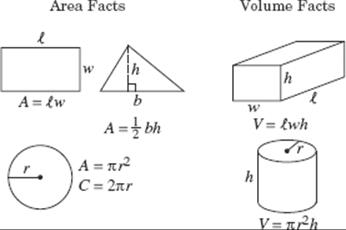
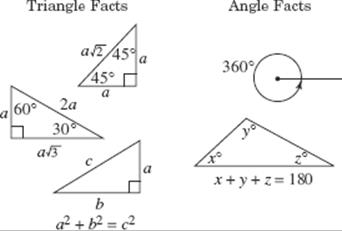
1. If 3x = 12, 5x =
(A) 2.4
(B) 14
(C) 15
(D) 20
(E) 60
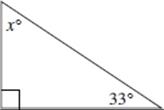
2. In the figure above, x =
(A) 33
(B) 57
(C) 67
(D) 123
(E) 147
3. If 8 – (8 – m) = 8, then m =
(A) –16
(B) –8
(C) 0
(D) 8
(E) 16
4. If ![]() of the members of the school chorus are boys, what is the ratio of girls to boys in the chorus?
of the members of the school chorus are boys, what is the ratio of girls to boys in the chorus?

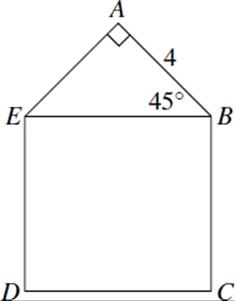
5. In the figure above, what is the perimeter of pentagon ABCDE, formed by right triangle EAB and square BCDE?
(A) 20
(B) 8 + 12![]()
(C) 8 + 16![]()
(D) 8 + 12![]()
(E) 32
6. If x4 = 10, what is x6 ?
(A) 10![]()
(B) 100
(C) 100![]()
(D) 1000
(E) 1000![]()
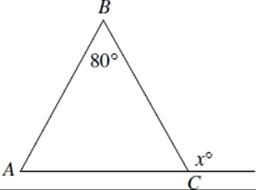
Note: Figure not drawn to scale
7. If, in the figure above, BC is the longest side of ![]() ABC and x is an integer, what is the smallest possible value of x?
ABC and x is an integer, what is the smallest possible value of x?
(A) 100
(B) 130
(C) 141
(D) 160
(E) 161
8. If ![]() is an integer, what is the remainder when a is divided by 5?
is an integer, what is the remainder when a is divided by 5?
(A) 1
(B) 2
(C) 3
(D) 4
(E) It cannot be determined from the information given.
9. Brigitte’s average (arithmetic mean) on her six math tests this marking period is 75. Fortunately for Brigitte, her teacher drops each student’s lowest grade, thus raising Brigitte’s average to 85. What was her lowest grade?
(A) 20
(B) 25
(C) 30
(D) 40
(E) 50
10. If m is an integer, which of the following could be true?
I. ![]() is an even integer.
is an even integer.
II. ![]() is an even integer.
is an even integer.
III. 17m is a prime.
(A) I only
(B) II only
(C) III only
(D) I and II only
(E) II and III only
11. Max purchased some shares of stock at $10 per share. Six months later the stock was worth $20 per share. What was the percent increase in the value of Max’s investment?
(A) 20%
(B) 50%
(C) 100%
(D) 200%
(E) 500%
12. Benjamin can type a full report in h hours. At this rate, how many reports can he type in m minutes?

13. The estate of a wealthy man was distributed as follows:10% to his wife, 5% divided equally among his three children, 5% divided equally among his five grandchildren, and the balance to a charitable trust. If the trust received $1,000,000, how much did each grandchild inherit?
(A) $10,000
(B) $12,500
(C) $20,000
(D) $62,500
(E) $100,000
14. If A, B, C, and D lie on the same straight line, and if AC = 2CD = 3BD, what is the value of the ratio ![]()
![]()
(E) It cannot be determined from the information given.
15. A car going 40 miles per hour set out on an 80-mile trip at 9:00 A.M. Exactly 10 minutes later, a second car left from the same place and followed the same route. How fast, in miles per hour, was the second car going if it caught up with the first car at 10:30 A.M.?
(A) 45
(B) 50
(C) 53
(D) 55
(E) 60
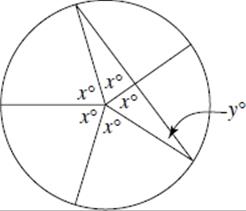
16. In the figure above, what is the ratio of y to x?
![]()
Questions 17 and 18 refer to the following definition.
For any positive integer n, ![]() represents the sum of the integers from 1 to n. For example,
represents the sum of the integers from 1 to n. For example, ![]() = 1 + 2 + 3 + 4 + 5 = 15.
= 1 + 2 + 3 + 4 + 5 = 15.
17. Which of the following is equal to ![]()

18. If ![]() = a and
= a and ![]() = b, what is the value of
= b, what is the value of ![]()
(A) a + b
(B) a + 10b
(C) a + b + 1000
(D) a + b + 10,000
(E) a + 1000b
19. A school’s honor society has 100 members: 40 boys and 60 girls, of whom 30 are juniors and 70 are seniors. What is the smallest possible number of senior boys in the society?
(A) 0
(B) 5
(C) 10
(D) 15
(E) 20
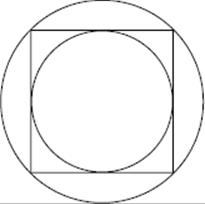
20. In the figure above, the small circle is inscribed in the square, which is inscribed in the large circle. What is the ratio of the area of the large circle to the area of the small circle?
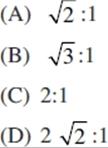
(E) It cannot be determined from the information given.
S T O P
YOU MAY GO BACK AND REVIEW THIS SECTION IN THE REMAINING TIME, BUT DO NOT WORK IN ANY OTHER SECTION UNTIL TOLD TO DO SO.
SECTION 4
Time—25 Minutes 35 Questions
Select the best answer to each of the following questions; then blacken the appropriate space on your answer sheet.
Some or all parts of the following sentences are underlined. The first answer choice, (A), simply repeats the underlined part of the sentence. The other four choices present four alternative ways to phrase the underlined part. Select the answer that produces the most effective sentence, one that is clear and exact, and blacken the appropriate space on your answer sheet. In selecting your choice, be sure that it is standard written English, and that it expresses the meaning of the original sentence.
Example:
The first biography of author Eudora Welty came out in 1998 and she was 89 years old at the time.
(A) and she was 89 years old at the time
(B) at the time when she was 89
(C) upon becoming an 89 year old
(D) when she was 89
(E) at the age of 89 years old
![]()
1. By the time we arrive in Italy, we have traveled through four countries.
(A) we have traveled through four countries
(B) we had traveled through four countries
(C) we will have traveled through four countries
(D) four countries will have been traveled through
(E) we through four countries shall have traveled
2. To say “My lunch was satisfactory” is complimentary, to say “My lunch was adequate” is not.
(A) complimentary, to say
(B) complementary, to say
(C) complementary, however, to say
(D) complimentary, but to say
(E) complementary to saying
3. When one debates the merits of the proposed reduction in our tax base, you should take into consideration the effect it will have on the schools and the other public services.
(A) you should take into consideration the effect
(B) you should consider the effect
(C) one should take the affect
(D) one takes into consideration the affect
(E) one should take into consideration the effect
4. We were afraid of the teacher’s wrath, due to his statement that he would penalize anyone who failed to hand in his term paper on time.
(A) wrath, due to his statement that
(B) wrath due to his statement that,
(C) wrath, inasmuch as his statement that,
(D) wrath because he had stated that
(E) wrath and he stated that,
5. Because the sports industry has become so popular is the reason that some universities have created new courses in sports marketing and event planning.
(A) popular is the reason that some universities have created new courses in sports marketing and event planning
(B) popular, some universities have created new courses in sports marketing and event planning
(C) popular, there have been new courses in sports marketing and event planning created by some universities
(D) popular is the reason that new courses in sports marketing and event planning have been created by some universities
(E) popular, they have created new courses in sports marketing and event planning at some universities
6. I have discovered that the subways in New York are as clean as any other city I have visited.
(A) as clean as any other city I have visited
(B) as clean as those in any other city I have visited
(C) as clean as those in any city I visited
(D) cleaner than any city I visited
(E) cleaner than any other city I have visited
7. Inflation in the United States has not and, we hope, never will reach a rate of 20 percent a year.
(A) has not and, we hope, never will reach
(B) has not reached and, we hope, never will
(C) has not and hopefully never will reach
(D) has not reached and, we hope, never will reach
(E) has not reached and hopefully never will
8. Godard is part biography, part cultural analysis, and it partly pays tribute to an artist who, the author believes, is one of the most influential of his time.
(A) analysis, and it partly pays tribute to an artist
(B) analysis, and part tribute to an artist
(C) analysis, and partly a payment of tribute to an artist
(D) analysis, also it partly pays tribute to an artist
(E) analysis, but there is a part that is a tribute to an artist
9. Embarrassment over the discovery of element 118, announced with great fanfare and then retracted amid accusations of scientific fraud, has left the nuclear physics community feeling bruised.
(A) element 118, announced with great fanfare and then retracted amid accusations of scientific fraud, has left
(B) element 118, which was announced with great fanfare and afterwards which was retracted amid accusations of scientific fraud, has left
(C) element 118, announced with great fanfare and then retracted amid accusations of scientific fraud, have left
(D) element 118 was announced with great fanfare and then was retracted amid accusations of scientific fraud, it has left
(E) element 118, it having been announced with great fanfare and then it was retracted amidst accusations of scientific fraud, has left
10. Life on Earth has taken a tremendous range of forms, but all species arise from the same molecular ingredients, these ingredients limit the chemical reactions that can occur within cells and so constrain what life can do.
(A) ingredients, these ingredients limit the chemical reactions that can occur within cells
(B) ingredients, these are ingredients that limit the chemical reactions that can occur within cells
(C) ingredients, these ingredients limit the chemical reactions that could occur within cells
(D) ingredients, which limit the chemical reactions that can occur within cells
(E) ingredients; but these ingredients limit the chemical reactions that can occur within cells
11. Thompson’s fictional retelling of Ignaz Semmelweis’s battle to eradicate childbed fever proved to at least one adolescent reader that taking a stand against the establishment, no matter the consequences, is worth the struggle.
(A) taking a stand against the establishment, no matter the consequences, is worth the struggle
(B) to take a stand against the establishment, it does not matter what the consequences are, is worth the struggle
(C) taking a stand against the establishment, despite the consequences, are worth the struggle
(D) if one takes a stand against the establishment, no matter the consequences, you will find it worth the trouble
(E) taking a stand against the establishment, irregardless of the consequences, is worth the trouble
The sentences in this section may contain errors in grammar, usage, choice of words, or idioms. Either there is just one error in a sentence or the sentence is correct. Some words or phrases are underlined and lettered; everything else in the sentence is correct.
If an underlined word or phrase is incorrect, choose that letter; if the sentence is correct, select No error. Then blacken the appropriate space on your answer sheet.
Example:
The region has a climate ![]() plants
plants ![]() rarely
rarely ![]() more than twelve inches
more than twelve inches ![]()
![]()
![]()
12. The lieutenant ![]() his men that the only information
his men that the only information ![]() to the captors was
to the captors was ![]() individual’s name, rank, and
individual’s name, rank, and ![]() .
. ![]()
13. ![]() the teacher ordered the student
the teacher ordered the student ![]() the dean’s office
the dean’s office ![]() the class disruption, she surprised us because she usually
the class disruption, she surprised us because she usually ![]() her own discipline problems.
her own discipline problems. ![]()
14. The youth scholarship program ![]() has been
has been ![]() by the members of the board
by the members of the board ![]() into
into ![]() at the beginning of next year.
at the beginning of next year. ![]()
15. The dearth ![]() customers during the
customers during the ![]() holiday season
holiday season ![]() several local restaurants
several local restaurants ![]() business.
business. ![]()
16. The two lawyers ![]() the statute
the statute ![]()
![]() they needed a judge to settle
they needed a judge to settle ![]() dispute.
dispute. ![]()
17. All of the team members, except ![]() ,
, ![]() anticipated
anticipated ![]() the national leagues, and now practice twice
the national leagues, and now practice twice ![]()
![]()
18. Everybody ![]() him has paid
him has paid ![]() dues; we
dues; we ![]() ways to make him understand the
ways to make him understand the ![]() prompt payment.
prompt payment. ![]()
19. Gustavo’s predicament was ![]() Hispanic recording artists: he could
Hispanic recording artists: he could ![]() in Spanish and
in Spanish and ![]() Latino audiences, or he could sing in English and risk
Latino audiences, or he could sing in English and risk ![]() of abandoning his roots.
of abandoning his roots. ![]()
20. ![]() after the
after the ![]() his first independent motion picture
his first independent motion picture ![]() Ben begin to think of himself
Ben begin to think of himself ![]() a professional filmmaker.
a professional filmmaker. ![]()
21. ![]()
![]() to be able
to be able ![]() we
we ![]() to receive tickets within the week.
to receive tickets within the week. ![]()
22. ![]() about the present conflict
about the present conflict ![]() I do not know how to resolve it without
I do not know how to resolve it without ![]() either you or
either you or ![]()
![]()
23. A new production of the opera Aida has ![]() been announced;
been announced; ![]() on an outdoor stage
on an outdoor stage ![]() live animals.
live animals.![]()
24. ![]() two or more members object to
two or more members object to ![]() the club, we shall have
the club, we shall have ![]() his application
his application ![]() membership.
membership.![]()
25. Thurgood Marshall ![]() the first black Supreme Court Justice
the first black Supreme Court Justice ![]() he was
he was ![]() this position by President Lyndon Johnson.
this position by President Lyndon Johnson. ![]()
26. Chinese scientists analyzing the genome of the SARS virus ![]() the
the ![]() rapidity with which it
rapidity with which it ![]() an animal pathogen into one
an animal pathogen into one ![]() infecting human cells.
infecting human cells. ![]()
27. When Freud introduced the notion that most mental processes ![]() determine our everyday thoughts, feelings, and
determine our everyday thoughts, feelings, and ![]() occur
occur ![]() his contemporaries rejected
his contemporaries rejected ![]() as impossible.
as impossible. ![]()
28. Artesian water ![]() an artesian well, a well
an artesian well, a well ![]() a water-bearing layer of rock or sand,
a water-bearing layer of rock or sand, ![]() the water level
the water level ![]() the top of the aquifer.
the top of the aquifer. ![]()
29. ![]() the Cultural Revolution in China, Li Huayi
the Cultural Revolution in China, Li Huayi ![]() as a "worker-artist," painting government propaganda posters,
as a "worker-artist," painting government propaganda posters, ![]() in private he developed
in private he developed ![]() artistic style.
artistic style. ![]()
The passage below is the unedited draft of a student’s essay. Parts of the essay need to be rewritten to make the meaning clearer and more precise. Read the essay carefully.
The essay is followed by six questions about changes that might improve all or part of the organization, development, sentence structure, use of language, appropriateness to the audience, or use of standard written English. In each case, choose the answer that most clearly and effectively expresses the student’s intended meaning. Indicate your choice by blackening the corresponding space on the answer sheet.
[1] From the colonial times until today, the appeal of the underdog has retained a hold on Americans. [2] It is a familiar sight today to see someone rooting for the underdog while watching a sports event on television.[3] Though that only happens if they don’t already have a favorite team. [4] Variations of the David and Goliath story are popular in both fact and fiction. [5] Horatio Alger stories, wondrous tales of conquering the West, and the way that people have turned rags-to-riches stories such as Vanderbilt into national myths are three examples of America’s fascination with the underdog.
[6] This appeal has been spurred by American tradition as well as an understandably selfish desire to feel good about oneself and life. [7] Part of the aura America has held since its creation is that the humblest and poorest person can make it here in America. [8] That dream is ingrained in the history of America.[9] America is made up of immigrants. [10] Most were poor when they came here. [11] They thought of America as the land of opportunity, where any little guy could succeed. [12] All it took was the desire to lift oneself up and some good honest work. [13] Millions succeeded on account of the American belief to honor and support the underdog in all its efforts.
[14] The underdog goes against all odds and defeats the stronger opponent with hope. [15] It makes people feel that maybe one day they too will triumph against the odds. [16] It changes their view of life’s struggles because they trust that in the end all their hardships will amount to something. [17] Despair has no place in a society where everyone knows that they can succeed.[18] It’s no wonder that the underdog has always had a tight hold upon American hopes and minds.
30. Which of the following is the best revision of the underlined sections of sentences 1 and 2 (below), so that the two sentences are combined into one?
From the colonial times until today, the appeal of the underdog has retained a hold on Americans. It is a familiar sight today to see someone rooting for the underdog while watching a sports event on television.
(A) the appeal of the underdog has retained a hold on Americans, and it is a familiar sight today to see underdogs being the one rooted for
(B) the appeal of the underdog has retained a hold on Americans, but it is a familiar sight today to see someone rooting for the underdog
(C) the underdog has retained a hold on Americans, who commonly root for the underdog, for example,
(D) the underdog has retained a hold on Americans, commonly rooting for the underdog
(E) the underdog’s appeal has retained a hold on Americans, for example, they commonly root for the underdog
31. To improve the coherence of paragraph 1, which of the following sentences should be deleted?
(A) Sentence 1
(B) Sentence 2
(C) Sentence 3
(D) Sentence 4
(E) Sentence 5
32. Considering the content of paragraph 2, which of the following is the best revision of the paragraph’s topic sentence, sentence 6?
(A) This appeal got spurred by American tradition as well as by an understandably selfish desire to feel good about oneself and one’s life.
(B) The appeal of the underdog has been spurred by American tradition.
(C) The appeal has been spurred by Americans’ traditional and selfish desire to feel good about themselves and life.
(D) American tradition as well as Americans’ desire to feel good about oneself and their life has spurred the appeal of underdogs.
(E) American traditions include an understandably selfish desire to feel good about themselves and the appeal of the underdog.
33. In the context of paragraph 2, which of the following is the best way to combine sentences 8, 9, 10, and 11?
(A) That dream is ingrained in the experience of America, a country made up of poor immigrants who believed that in this land of opportunity any little guy had a chance to succeed.
(B) That dream was ingrained in our history, a country made up of immigrants, poor and hopeful that any little guy is able to succeed in America, the land of opportunity.
(C) That dream has been ingrained America’s history that poor immigrants look on America as a land of opportunity, which any little guy had been able to succeed in.
(D) The American experience has ingrained in it the dream that by immigrants coming to this country poorly could succeed because America is the land of opportunity.
(E) Ingrained in the American experience is the dream of poor immigrants that they could succeed here, after all, this is the land of opportunity.
34. In view of the sentences that precede and follow sentence 13, which of the following is the most effective revision of sentence 13?
(A) Americans believe that the underdog should be honored and supported, which led to their success.
(B) Because America believed in honoring and supporting the underdog, they succeed.
(C) And succeed they did because of America’s commitment to honor and support the underdog.
(D) Honoring and supporting underdogs is a firmly held value in America, and it led to the success of underdogs.
(E) They succeeded with their efforts to be supported and honored by America.
35. Which of the following revisions of sentence 14 is the best transition between paragraphs 3 and 4?
(A) Underdogs, in addition, went against all odds and with hope defeat stronger opponents.
(B) The underdog, feeling hopeful, going against all odds, and defeating stronger opponents.
(C) It is the hope of the underdog who goes against the odds and defeats the stronger opponent.
(D) The triumph of the underdog over a strong opponent inspires hope.
(E) The underdog triumphs against all odds and defeats the stronger opponents.
S T O P
YOU MAY GO BACK AND REVIEW THIS SECTION IN THE REMAINING TIME, BUT DO NOT WORK IN ANY OTHER SECTION UNTIL TOLD TO DO SO.
SECTION 6
Time—25 Minutes 24 Questions
Select the best answer to each of the following questions; then blacken the appropriate space on your answer sheet.
Each of the following sentences contains one or two blanks; each blank indicates that a word or set of words has been left out. Below the sentence are five words or phrases, lettered A through E. Select the word or set of words that best completes the sentence.
Example:
Fame is ----; today’s rising star is all too soon tomorrow’s washed-up has-been.
(A) rewarding
(B) gradual
(C) essential
(D)spontaneous
(E)transitory
![]()
1. The civil rights movement did not emerge from obscurity into national prominence overnight; on the contrary, it captured the public’s imagination only --.
(A) fruitlessly
(B) unimpeachably
(C) momentarily
(D) expeditiously
(E) gradually
2. The seventeenth-century writer Mary Astell was a rare phenomenon, a single woman who maintained and even ---- a respectable reputation while earning a living by her pen.
(A) eclipsed
(B) impaired
(C) decimated
(D) avoided
(E) enhanced
3. An optimistic supporter of the women’s movement, Kubota contends that recent ---- by Japanese women in the business world are meaningful and indicative of ---- opportunity to come.
(A) advances..diminished
(B) strides..greater
(C) innovations..marginal
(D) retreats..theoretical
(E) failures..hidden
4. The ---- ambassador was but ---- linguist; yet he insisted on speaking to foreign dignitaries in their own tongues without resorting to a translator’s aid.
(A) eminent..an indifferent
(B) visiting..a notable
(C) revered..a talented
(D) distinguished..a celebrated
(E) ranking..a sensitive
5. Nowadays life models—men and women who pose in the nude for artists—seem curiously ----, relics of a bygone age when art students labored amid skeletons and anatomical charts, learning to draw the human body as painstakingly as medical students learn to ---- it.
(A) anachronistic..sketch
(B) archaic..dissect
(C) contemporary..diagnose
(D) stereotyped..examine
(E) daring..cure
Read the passages below, and then answer the questions that follow them. The correct response may be stated outright or merely suggested in the passages.
Questions 6–9 are based on the following passages.
Passage 1
It was the voyageur who struck my imagination—
the canoe man who carried loads of hundreds of
pounds and paddled 18 hours a day fighting
waves waves and storms. His muscle and brawn supplied
Line (5) the motive power for French-Canadian
exploration and trade, but despite the harshness of
his life—the privation, suffering, and constant
threat of death by exposure, drowning, and Indian
attack—he developed an unsurpassed nonchalance
(10) and joy in the wilderness. These exuberant
men, wearing red sashes and caps and singing in
the face of disaster, were the ones who stood out.
Passage 2
The French voyageurs (“travelers”) in essence
were fur traders, commercial agents hired by a
(15) merchant company to conduct trade on its behalf.
In Canada, the French fur trade in Montreal was
taken over by British fur traders, who provided
the capital for the enterprise. The voyageurs, for
their part, supplied their knowledge of Indian
(20) tribal customs and wilderness trails, as well as
their expertise in traveling by canoe. They established
a system of canoe convoys between
fur-trading posts that ran from Montreal to the
western plains, well into the region now known as
(25) Canada’s North West Territories.
6. In line 1, “struck” most nearly means
(A) picketed
(B) inflicted
(C) impressed
(D) dismantled
(E) overthrew
7. The author of Passage 1 is most affected by the voyageur’s
(A) inventiveness
(B) hardships
(C) strength
(D) zest
(E) diligence
8. Compared to the author of Passage 2, the author of Passage 1 regards the voyageurs with more
(A) overt cynicism
(B) objective detachment
(C) open admiration
(D) misguided affection
(E) marked ambivalence
9. Unlike the author of Passage 2, the author of Passage 1 makes use of
(A) direct quotation
(B) historical research
(C) literary references
(D) statistical data
(E) personal voice
Questions 10–15 are based on the following passage.
The following passage on the formation of oil is excerpted from a novel about oil exploration written by Alistair MacLean.
Five main weather elements act upon rock.
Frost and ice fracture rock. It can be gradually
eroded by airborne dust. The action of the seas,
whether through the constant movement of tides
Line (5) or the pounding of heavy storm waves, remorselessly
wears away the coastlines. Rivers are
immensely powerful destructive agencies—one
has but to look at the Grand Canyon to appreciate
their enormous power. And such rocks as escape
(10) all these influences are worn away over the eons
by the effect of rain.
Whatever the cause of erosion, the net result is
the same. The rock is reduced to its tiniest possible
constituents—rock particles or, simply, dust.
(15) Rain and melting snow carry this dust down to
the tiniest rivulets and the mightiest rivers, which,
in turn, transport it to lakes, inland seas and the
coastal regions of the oceans. Dust, however fine
and powdery, is still heavier than water, and
(20) whenever the water becomes sufficiently still, it
will gradually sink to the bottom, not only in
lakes and seas but also in the sluggish lower
reaches of rivers and where flood conditions
exist, in the form of silt.
(25) And so, over unimaginably long reaches of
time, whole mountain ranges are carried down to
the seas, and in the process, through the effects of
gravity, new rock is born as layer after layer of
dust accumulates on the bottom, building up to a
(30) depth of ten, a hundred, perhaps even a thousand
feet, the lowermost layers being gradually
compacted by the immense and steadily increasing
pressures from above, until the particles fuse
together and reform as a new rock.
(35) It is in the intermediate and final processes of
the new rock formation that oil comes into being.
Those lakes and seas of hundreds of millions of
years ago were almost choked by water plants and
the most primitive forms of aquatic life. On
(40) dying, they sank to the bottom of the lakes and
seas along with the settling dust particles and
were gradually buried deep under the endless layers
of more dust and more aquatic and plant life
that slowly accumulated above them. The passing
(45) of millions of years and the steadily increasing
pressures from above gradually changed the
decayed vegetation and dead aquatic life into oil.
Described this simply and quickly, the process
sounds reasonable enough. But this is where the
(50) gray and disputatious area arises. The conditions
necessary for the formation of oil are known; the
cause of the metamorphosis is not. It seems probable
that some form of chemical catalyst is
involved, but this catalyst has not been isolated.
(55) The first purely synthetic oil, as distinct from secondary
synthetic oils such as those derived from
coal, has yet to be produced. We just have to
accept that oil is oil, that it is there, bound up in
rock strata in fairly well-defined areas throughout
(60) the world but always on the sites of ancient seas
and lakes, some of which are now continental
land, some buried deep under the encroachment
of new oceans.
10. According to the author, which of the following statements is (are) true?
I. The action of the seas is the most important factor in erosion of Earth’s surface.
II. Scientists have not been able to produce a purely synthetic oil in the laboratory.
III. Gravity plays an important role in the formation of new rock.
(A) I only
(B) II only
(C) III only
(D) I and III only
(E) II and III only
11. The Grand Canyon is mentioned in the first paragraph to illustrate
(A) the urgent need for dams
(B) the devastating impact of rivers
(C) the effect of rain
(D) a site where oil may be found
(E) the magnificence of nature
12. According to the author, our understanding of the process by which oil is created is
(A) biased
(B) systematic
(C) erroneous
(D) deficient
(E) adequate
13. We can infer that prospectors should search for oil deposits
(A) wherever former seas existed
(B) in mountain streambeds
(C) where coal deposits are found
(D) in the Grand Canyon
(E) in new rock formations
14. The author does all of the following EXCEPT
(A) describe a process
(B) state a possibility
(C) cite an example
(D) propose a solution
(E) mention a limitation
15. In line 23, “reaches” most nearly means
(A) grasps
(B) unbroken stretches
(C) range of knowledge
(D) promontories
(E) juxtapositions
Questions 16–24 are based on the following passage.
The following passage is excerpted from a book on the meaning and importance of fairy tales by noted child psychologist Bruno Bettelheim.
Plato—who may have understood better what
forms the mind of man than do some of our
contemporaries who want their children exposed only
to “real” people and everyday events—knew what
Line (5) intellectual experiences make for true humanity.
He suggested that the future citizens of his ideal
republic begin their literary education with the
telling of myths, rather than with mere facts or
so-called rational teachings. Even Aristotle, master
(10) of pure reason, said: “The friend of wisdom is
also a friend of myth.”
Modern thinkers who have studied myths and
fairy tales from a philosophical or psychological
viewpoint arrive at the same conclusion, regardless
(15) of their original persuasion. Mircea Eliade,
for one, describes these stories as “models for
human behavior [that,] by that very fact, give
meaning and value to life.” Drawing on anthropological
parallels, he and others suggest that myths
(20) and fairy tales were derived from, or give
symbolic expression to, initiation rites or other rites of
passage—such as metaphoric death of an old,
inadequate self in order to be reborn on a higher
plane of existence. He feels that this is why these
(25) tales meet a strongly felt need and are carriers
of such deep meaning.
Other investigators with a depth-psychological
orientation emphasize the similarities between the
fantastic events in myths and fairy tales and those
(30) in adult dreams and daydreams—the fulfillment
of wishes, the winning out over all competitors,
the destruction of enemies—and conclude that
one attraction of this literature is its expression of
that which is normally prevented from coming to
(35) awareness.
There are, of course, very significant differences
between fairy tales and dreams. For example,
in dreams more often than not the wish
fulfillment is disguised, while in fairy tales much
(40) of it is openly expressed. To a considerable
degree, dreams are the result of inner pressures
that have found no relief, of problems that beset a
person to which he knows no solution and to
which the dream finds none. The fairy tale does
(45) the opposite: it projects the relief of all pressures
and not only offers ways to solve problems but
promises that a “happy” solution will be found.
We cannot control what goes on in our dreams.
Although our inner censorship influences what we
(50) may dream, such control occurs on an unconscious
level. The fairy tale, on the other hand, is
very much the result of common conscious and
unconscious content having been shaped by the
conscious mind, not of one particular person, but
(55) the consensus of many in regard to what they
view as universal human problems, and what they
accept as desirable solutions. If all these elements
were not present in a fairy tale, it would not be
retold by generation after generation. Only if a
(60) fairy tale met the conscious and unconscious
requirements of many people was it repeatedly
retold, and listened to with great interest. No
dream of a person could arouse such persistent
interest unless it was worked into a myth, as was
(65) the story of the pharaoh’s dream as interpreted by
Joseph in the Bible.
There is general agreement that myths and fairy
tales speak to us in the language of symbols representing
unconscious content. Their appeal is simultaneously
(70) to our conscious mind, and to our need
for ego-ideals as well. This makes it very effective;
and in the tales’ content, inner psychological
phenomena are given body in symbolic form.
16. In the opening paragraph, the author quotes Plato and Aristotle primarily in order to
(A) define the nature of myth
(B) contrast their opposing points of view
(C) support the point that myths are valuable
(D) prove that myths originated in ancient times
(E) give an example of depth psychology
17. The author’s comment about people who wish their children exposed only to actual historic persons and commonplace events (lines 3 and 4) suggests he primarily views such people as
(A) considerate of their children’s welfare
(B) misguided in their beliefs
(C) determined to achieve their ends
(D) more rational than the ancients
(E) optimistic about human nature
18. By “Plato . . . knew what intellectual experiences make for true humanity” (lines 1–5), the author means that
(A) Plato comprehended the effects of the intellectual life on real human beings
(B) Plato realized how little a purely intellectual education could do for people’s actual wellbeing
(C) Plato grasped which sorts of experiences helped promote the development of truly humane individuals
(D) actual human beings are transformed by reading the scholarly works of Plato
(E) human nature is a product of mental training according to the best philosophical principles
19. In line 15, “persuasion” most nearly means
(A) enticement
(B) convincing force
(C) political party
(D) opinion
(E) gullibility
20. Lines 12–18 suggest that Mircea Eliade is most likely
(A) a writer of children’s literature
(B) a student of physical anthropology
(C) a twentieth century philosopher
(D) an advocate of practical education
(E) a contemporary of Plato
21. In line 69, “appeal” most nearly means
(A) plea
(B) wistfulness
(C) prayer
(D) request
(E) attraction
22. It can be inferred from the passage that the author’s interest in fairy tales centers chiefly on their
(A) literary qualities
(B) historical background
(C) factual accuracy
(D) psychological relevance
(E) ethical weakness
23. Which of the following best describes the author’s attitude toward fairy tales?
(A) Reluctant fascination
(B) Wary skepticism
(C) Scornful disapprobation
(D) Indulgent tolerance
(E) Open approval
24. According to the passage, fairy tales differ from dreams in which of the following characteristics?
I. The shared nature of their creation
II. The convention of a happy ending
III. Enduring general appeal
(A) I only
(B) II only
(C) I and II only
(D) II and III only
(E) I, II, and III
S T O P
YOU MAY GO BACK AND REVIEW THIS SECTION IN THE REMAINING TIME, BUT DO NOT WORK DO NOT IN ANY OTHER SECTION UNTIL TOLD TO DO SO.
SECTION 7
Time—25 Minutes 18 Questions 7
You have 25 minutes to answer the 8 multiple-choice questions and 10 student-produced response questions in this section.
For each multiple-choice question, determine which of the five choices is correct and blacken the corresponding choice on your answer sheet. You may use any blank space on the page for your work.
Notes:
• You may use a calculator whenever you think it will be helpful.
• Only real numbers are used. No question or answer on this test involves a complex or imaginary number.
• Use the diagrams provided to help you solve the problems. Unless you see the words “Note: Figure not drawn to scale” under a diagram, it has been drawn as accurately as possible. Unless it is stated that a figure is three-dimensional, you may assume it lies in a plane.
• For any function f, the domain, unless specifically restricted, is the set of all real numbers for which f (x) is also a real number.
Reference Information


1. If Wally’s Widget Works is open exactly 20 days each month and produces 80 widgets each day it is open, how many years will it take to produce 96,000 widgets?
(A) less than 5
(B) 5
(C) more than 5 but less than 10
(D) 10
(E) more than 10
2. The equation ![]() has two solutions. What is the sum of these solutions?
has two solutions. What is the sum of these solutions?
(A) 0
(B) 9
(C) 18
(D) 20
(E) 298
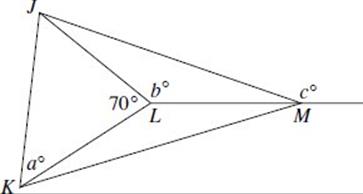
3. In the figure above, JL = KL = LM and m![]() JLK = 70. This information is sufficient to determine the value of which of the following?
JLK = 70. This information is sufficient to determine the value of which of the following?
(A) a only
(B) b only
(C) a and b only
(D) b and c only
(E) a, b, and c
4. A (5, 1) lies on a circle whose center is O (1, 5). If AB is a diameter, what are the coordinates of B?
(A) (3, 3)
(B) (6, 6)
(C) (–1, 5)
(D) (–1, 10)
(E) (–3, 9)
5. What is the volume, in cubic inches, of a cube whose total surface area is 216 square inches?
(A) 6
(B) 18
(C) 36
(D) 216
(E) 1296
6. In a class, 20 children were sharing equally the cost of a present for their teacher. When 4 of the children decided not to contribute, each of the other children had to pay $1.50 more. How much, in dollars, did the present cost?
(A) 50
(B) 80
(C) 100
(D) 120
(E) 150
7. For how many integers, x, is the function f(x) = ![]() undefined?
undefined?
(A) None
(B) 4
(C) 5
(D) 7
(E) Infinitely many
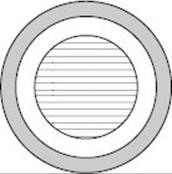
The three circles have the same center. The radii of the circles are 3, 4, and 5.
8. If a point in the figure above is chosen at random, what is the probability that the point lies in the shaded outer ring?
(A) ![]()
(B) ![]()
(C) ![]()
(D) ![]()
(E) ![]()
Directions for Student-Produced Response Questions (Grid-ins)
In questions 9–18, first solve the problem, and then enter your answer on the grid provided on the answer sheet. The instructions for entering your answers are as follows:
• First, write your answer in the boxes at the top of the grid.
• Second, grid your answer in the columns below the boxes.
• Use the fraction bar in the first row or the decimal point in the second row to enter fractions and decimal answers.
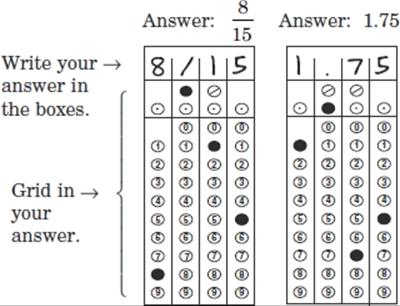
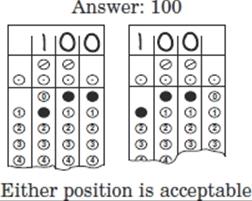
• Grid only one space in each column.
• Entering the answer in the boxes is recommended as an aid in gridding, but is not required.
• The machine scoring your exam can read only what you grid, so you must grid in your answers correctly to get credit.
• If a question has more than one correct answer, grid in only one of these answers.
• The grid does not have a minus sign, so no answer can be negative.
• A mixed number must be converted to an improper fraction or a decimal before it is gridded. Enter ![]() as 5/4 or 1.25; the machine will interpret 1 1/4 as
as 5/4 or 1.25; the machine will interpret 1 1/4 as ![]() and mark it wrong.
and mark it wrong.
• All decimals must be entered as accurately as possible. Here are the three acceptable ways of gridding
![]() = 0.272727...
= 0.272727...
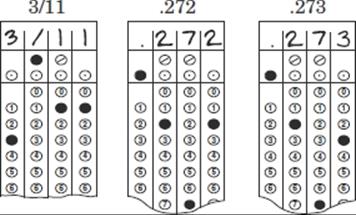
• Note that rounding to .273 is acceptable, because you are using the full grid, but you would receive no credit for .3 or .27, because these answers are less accurate.
9. If a = 3 and b = –3, what is the value of 3a – 2b?
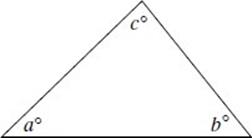
10. If a:b:c = 6:7:11, what is the value of c – a?
11. What is the perimeter of a right triangle if the lengths of its two smallest sides are 15 and 36?
12. There are 250 people on a line outside a theater. If Jack is the 25th person from the front, and Jill is the 125th person from the front, how many people are between Jack and Jill?
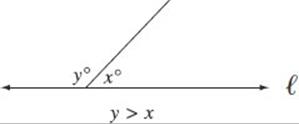
Note: Figure not drawn to scale
13. In the figure above, x and y are integers. What is the largest possible value of x?
14. Five people shared a prize of $100. Each one received a whole number of dollars, and no two people received the same amount. If the largest share was $30 and the smallest share was $15, what is the most money that the person with the third largest share could have received? (Grid in your answer without a dollar sign.)
15. The average (arithmetic mean) of a set of 9 numbers is 99. After one of the numbers is deleted from the set, the average of the remaining numbers is 89. What number was deleted?
16. The sum of three different positive integers is 12.Let g be the greatest possible product of the three integers, and let be the least possible product of the integers. What is the value of g – ![]() ?
?
17. In a right triangle, ![]() of the length of the longer leg is equal
of the length of the longer leg is equal ![]() to of the length of the shorter leg. What is the ratio of the length of the hypotenuse to the length of the shorter leg?
to of the length of the shorter leg. What is the ratio of the length of the hypotenuse to the length of the shorter leg?
18. If x varies inversely with y and varies directly with z, and if y and z are both 12 when x = 3, what is the value of y + z when x = 4?
S T O P
YOU MAY GO BACK AND REVIEW THIS SECTION IN THE REMAINING TIME, BUT DO NOT WORK IN ANY OTHER SECTION UNTIL TOLD TO DO SO.
SECTION 8
Time—20 Minutes 19 Questions
Select the best answer to each of the following questions; then blacken the appropriate space on your answer sheet.
Each of the following sentences contains one or two blanks; each blank indicates that a word or set of words has been left out. Below the sentence are five words or phrases, lettered A through E. Select the word or set of words that best completes the sentence.
Example:
Fame is ----; today’s rising star is all too soon tomorrow’s washed-up has-been.
(A) rewarding
(B) gradual
(C) essential
(D) spontaneous
(E) transitory
![]()
1. Most of the settlements that grew up near the logging camps were ---- affairs, thrown together in a hurry because people needed to live on the job.
(A) protracted
(B) unobtrusive
(C) nomadic
(D) ramshackle
(E) banal
2. Quick-breeding and immune to most pesticides, cockroaches are so ---- that even a professional exterminator may fail to ---- them.
(A) vulnerable..eradicate
(B) widespread..discern
(C) fragile..destroy
(D) hardy..eliminate
(E) numerous..detect
3. The patient bore the pain ----, neither wincing nor whimpering when the incision was made.
(A) histrionically
(B) stoically
(C) sardonically
(D) poorly
(E) marginally
4. The actor’s stories of backstage feuds and rivalry might be thought ---- were there not so many corroborating anecdotes from other theatrical personalities.
(A) pantomime
(B) ambiguity
(C) approbation
(D) hyperbole
(E) vainglory
5. Wemmick, the soul of kindness in private, is obliged in ---- to be uncompassionate and even ---- on behalf of his employer, the harsh lawyer Jaggers.
(A) conclusion..careless
(B) principle..contradictory
(C) theory..esoteric
(D) court..judicious
(E) public..ruthless
6. Although Roman original contributions to government, jurisprudence, and engineering are commonly acknowledged, the artistic legacy of the Roman world continues to be judged widely as ---- the magnificent Greek traditions that preceded it.
(A) an improvement on
(B) an echo of
(C) a resolution of
(D) a precursor of
(E) a consummation of
The questions that follow the next two passages relate to the content of both, and to their relationship. The correct response may be stated outright in the passage or merely suggested.
Questions 7–19 are based on the following passages.
The following passages are taken from memoirs by two young American writers, each of whom records his reaction to the prospect of visiting his ancestral homeland.
Passage 1
Thomas Wolfe said that going home again is
like stepping into a river. You cannot step into the
same river twice; you cannot go home again.
After a very long time away, you will not find the
Line (5) same home you left behind. It will be different,
and so will you. It is quite possible that home will
not be home at all, meaningless except for its
sentimental place in your heart. At best it will point
the long way back to where you started, its value
(10) lying in how it helped to shape you and in the
part of home you have carried away.
Alex Haley went to Africa in the mid-sixties.
Somehow he had managed to trace his roots back
to a little village called Juffure, upriver from
(15) Banjul in the forests of The Gambia. It was the
same village from which his ancestors had been
stolen and forced into slavery. In some way Haley
must have felt he was returning home: a flood of
emotions, an awakening of the memories hidden
(20) in his genes.
Those were the two extremes between which I
was trapped. I could not go home again, yet here I
was. Africa was so long ago the land of my
ancestors that it held for me only a symbolic
(25) significance. Yet there was enough to remind me
that what I carry as a human being has come in
part from Africa. I did not feel African, but was
beginning to feel not wholly American anymore
either. I felt like an orphan, a waif without a
(30) home.
I was not trying to find the village that had
once been home to my people, nor would I stand
and talk to people who could claim to be my relatives,
as Haley had done. The thought of running
(35) into someone who looked like a relative terrified
me, for that would have been too concrete, too
much proof. My Africanism was abstract and I
wanted it to remain so. I did not need to hear the
names of my ancient ancestors or know what they
(40) looked like. I had seen the ways they loved their
children in the love of my father. I would see
their faces and their smiles one day in the eyes of
my children.
Haley found what he was seeking. I hardly
(45) knew what I was looking for, except perhaps to
know where home once was, to know how much
of me is really me, how much of being black has
been carried out of Africa.
Passage 2
I am a Sansei, a third-generation Japanese-
(50) American. In 1984, through luck and through
some skills as a poet, I traveled to Japan. My
reasons for going were not very clear.
At the time, I’d been working as an arts
administrator in the Writers-in-the-Schools program,
(55) sending other writers to grade schools and
high schools throughout Minnesota. It wasn’t taxing,
but it didn’t provide the long stretches
needed to plunge into my own work. I had
applied for a U.S./Japan Creative Artist Exchange
(60) Fellowship mainly because I wanted time to
write.
Japan? That was where my grandparents came
from; it didn’t have much to do with my present
life.
(65) For me Japan was cheap baseballs, Godzilla,
weird sci-fi movies like Star Man, where you
could see the strings that pulled him above his enemies,
flying in front of a backdrop so poorly made
even I, at eight, was conscious of the fakery. Then
(70) there were the endless hordes storming GI’s in
war movies. Before the television set, wearing my
ever-present Cubs cap, I crouched near the sofa,
saw the enemy surrounding me. I shouted to my
men, hurled a grenade. I fired my gun. And the
(75) Japanese soldiers fell before me, one by one.
So, when I did win the fellowship, I felt I was
going not as an ardent pilgrim, longing to return
to the land of his grandparents, but more like a
contestant on a quiz show who finds himself winning
(80) a trip to Bali or the Bahamas. Of course, I
was pleased about the stipend, the plane fare for
me and my wife, and the payments for Japanese
lessons, both before the trip and during my stay.
I was also excited that I had beat out several
(85) hundred candidates in literature and other fields
for one of the six spots. But part of me wished the
prize was Paris, not Tokyo. I would have preferred
French bread and Brie over sashimi and
rice, Baudelaire and Proust over Basho and
(90) Kawabata, structuralism and Barthes over Zen
and D. T. Suzuki.
This contradiction remained. Much of my life I
had insisted on my Americanness, had shunned
most connections with Japan and felt proud I
knew no Japanese; yet I was going to Japan as a
(95) poet, and my Japanese ancestry was there in my
poems—my grandfather, the relocation camps,
the hibakusha (victims of the atomic bomb), a
picnic of Nisei (second-generation Japanese-
Americans), my uncle who fought in the 442nd.
(100) True, the poems were written in blank verse,
rather than haiku, tanka, or haibun. But perhaps
it’s a bit disingenuous to say that I had no longing
to go to Japan; it was obvious my imagination
had been traveling there for years, unconsciously
(105) swimming the Pacific, against the tide of my family’s
emigration, my parents’ desire, after the
internment camps, to forget the past.
7. Wolfe’s comment referred to in lines 1–6 represents
(A) a digression from the author’s thesis
(B) an understatement of the situation
(C) a refutation of the author’s central argument
(D) a figurative expression of the author’s point
(E) an example of the scientific method
8. According to lines 8–11, the most positive outcome of attempting to go home again would be for you to
(A) find the one place you genuinely belong
(B) recognize the impossibility of the task
(C) grasp how your origins have formed you
(D) reenter the world of your ancestors
(E) decide to stay away for shorter periods of time
9. Throughout Passage 1, the author seeks primarily to convey
(A) his resemblance to his ancestors
(B) his ambivalence about his journey
(C) the difficulties of traveling in a foreign country
(D) his need to deny his American origins
(E) the depth of his desire to track down his roots
10. The statement “I could not go home again, yet here I was” (lines 22 and 23) represents
(A) a paradox
(B) a prevarication
(C) an interruption
(D) an analogy
(E) a fallacy
11. In line 24, “held” most nearly means
(A) grasped
(B) believed
(C) absorbed
(D) accommodated
(E) possessed
12. By “my own work” (line 58), the author of Passage 2 refers to
(A) seeking his ancestral roots
(B) teaching in high school
(C) writing a travel narrative
(D) creating poetry
(E) directing art programs
13. In lines 56–57, “taxing” most nearly means
(A) imposing
(B) obliging
(C) demanding
(D) accusatory
(E) costly
14. The author’s purpose in describing the war movie incident (lines 70–74) most likely is to
(A) indicate the depth of his hatred for the Japanese
(B) show the extent of his self-identification as an American
(C) demonstrate the superiority of American films to their Japanese counterparts
(D) explore the range of his interest in contemporary art forms
(E) explain why he had a particular urge to travel to Japan
15. By “a trip to Bali or the Bahamas” (line 80) the author wishes to convey
(A) his love for these particular vacation sites
(B) the impression that he has traveled to these places before
(C) his preference for any destination other than Japan
(D) his sense of Japan as just another exotic destination
(E) the unlikelihood of his ever winning a second trip
16. The author’s attitude toward winning the fellowship can best be described as one of
(A) graceful acquiescence
(B) wholehearted enthusiasm
(C) unfeigned gratitude
(D) frank dismay
(E) marked ambivalence
17. The author concludes Passage 2 with
(A) a rhetorical question
(B) a eulogy
(C) an epitaph
(D) an extended metaphor
(E) a literary allusion
18. Both passages are concerned primarily with the subject of
(A) ethnic identity
(B) individual autonomy
(C) ancestor worship
(D) racial purity
(E) genealogical research
19. For which of the following statements or phrases from Passage 1 is a parallel idea not conveyed in Passage 2?
(A) Africa “held for me only a symbolic significance” (lines 24 and 25)
(B) “I did not feel African” (line 27)
(C) “I felt like an orphan, a waif without a home” (lines 29 and 30)
(D) “I hardly knew what I was looking for” (lines 44 and 45)
(E) “An awakening of the memories hidden in his genes” (lines 19 and 20)
S T O P
YOU MAY GO BACK AND REVIEW THIS SECTION IN THE REMAINING TIME, BUT DO NOT WORK IN ANY OTHER SECTION UNTIL TOLD TO DO SO.
SECTION 9
Time—20 Minutes 16 Questions 9
For each problem in this section determine which of the five choices is correct and blacken the corresponding choice on your answer sheet. You may use any blank space on the page for your work.
Notes:
• You may use a calculator whenever you think it will be helpful.
• Only real numbers are used. No question or answer on this test involves a complex or imaginary number.
• Use the diagrams provided to help you solve the problems. Unless you see the words “Note: Figure not drawn to scale” under a diagram, it has been drawn as accurately as possible. Unless it is stated that a figure is three-dimensional, you may assume it lies in a plane.
• For any function f, the domain, unless specifically restricted, is the set of all real numbers for which f (x) is also a real number.
Reference Information


1. If 3x = 36, then = ![]()
(A) 3
(B) 4
(C) 6
(D) 9
(E) 12
2. If a ![]() =
= ![]() b, then
b, then ![]() =
=
(A) ![]()
(B) ![]()
(C) 1
(D) ![]()
(E) ![]()
3. The weights, in kilograms, of five students are 48, 56, 61, 52, and 57. If 1 kilogram = 2.2 pounds, how many of the students weigh over 120 pounds?
(A) 1
(B) 2
(C) 3
(D) 4
(E) 5
4. From 1980 to 1990, the value of a share of stock of XYZ Corporation doubled every year. If in 1990 a share of the stock was worth $80, in what year was it worth $10?
(A) 1984
(B) 1985
(C) 1986
(D) 1987
(E) 1988
5. The average (arithmetic mean) of two numbers is a. If one of the numbers is 10, what is the other?
(A) 2a + 10
(B) 2a – 10
(C) 2(a – 10)
(D) ![]()
(E) ![]()
6. The chart below shows the value of an investment on January 1 of each year from 2005 to 2010. During which year was the percent increase in the value of the investment the greatest?
|
Year |
Value |
|
2005 |
$150 |
|
2006 |
$250 |
|
2007 |
$450 |
|
2008 |
$750 |
|
2009 |
$1200 |
|
2010 |
$1800 |
(A) 2005
(B) 2006
(C) 2007
(D) 2008
(E) 2009
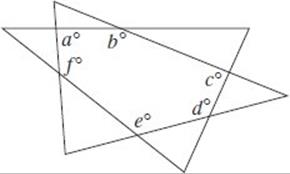
7. In the figure above, what is the value of a + b + c + d + e + f?
(A) 360
(B) 540
(C) 720
(D) 900
(E) It cannot be determined from the information given.
8. If the circumference of a circle is equal to the perimeter of a square whose sides are π, what is the radius of the circle?
(A) 1
(B) 2
(C) 4
(D) ![]()
(E) 2![]()
9. The first term of a sequence is 1 and every term after the first one is 1 more than the square of the preceding term. What is the fifth term?
(A) 25
(B) 26
(C) 256
(D) 676
(E) 677
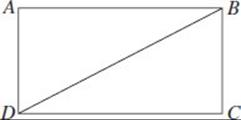
Note: Figure not drawn to scale
10. If the perimeter of rectangle ABCD above is 14, what is the perimeter of ![]() BCD?
BCD?
(A) 7
(B) 12
(C) 7 + ![]()
(D) 7 + ![]()
(E) It cannot be determined from the information given.
11. Jordan has taken five math tests so far this semester. If he gets a 70 on his next test, that grade will lower his test average (arithmetic mean) by 4 points. What is his average now?
(A) 74
(B) 85
(C) 90
(D) 94
(E) 95
12. If f(x) = x2 – 3x and g(x) = f(3x), what is g(–10)?
(A) 210
(B) 390
(C) 490
(D) 810
(E) 990
13. The expression  is equivalent to which of the following?
is equivalent to which of the following?
(A) ![]()
(B) ![]()
(C) ![]()
(D) ![]()
(E) ![]()
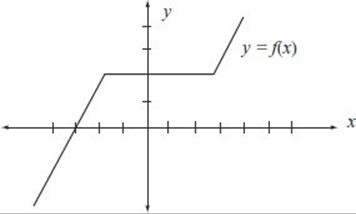
14. The figure above is the graph of the function y = f(x). What are the x-coordinates of the points where the graph of y = f(x – 2) intersects the x-axis?
(A) Only –5
(B) Only –1
(C) –5 and –1
(D) All numbers between –2 and 3
(E) The graph of y = f(x – 2) does not intersect the x-axis.
15. Store 1 is a full-service retail store that charges regular prices. Store 2 is a self-service factory-outlet store that sells all items at a reduced price. In January 2004, each store sold three brands of DVD players. The numbers of DVD players sold and their prices are shown in the following tables.
Number of DVD Players Sold

Prices of DVD Players

What was the difference between Store 1 and Store 2 in the dollar values of the total sales of the three brands of DVD players?
(A) 40
(B) 80
(C) 140
(D) 330
(E) 1300
16. A = {2, 3} B = {4, 5} C = {6, 7}
In how many ways is it possible to pick 1 number from each set, so that the 3 numbers could be the lengths of the three sides of a triangle?
(A) 0
(B) 2
(C) 4
(D) 6
(E) 8
S T O P
YOU MAY GO BACK AND REVIEW THIS SECTION IN THE REMAINING TIME, BUT DO NOT WORK IN ANY OTHER SECTION UNTIL TOLD TO DO SO.
SECTION 10
Time—10 Minutes 14 Questions
For each of the following questions, select the best answer from the choices provided and fill in the appropriate circle on the answer sheet.
Some or all parts of the following sentences are underlined. The first answer choice, (A), simply repeats the underlined part of the sentence. The other four choices present four alternative ways to phrase the underlined part. Select the answer that produces the most effective sentence, one that is clear and exact, and blacken the appropriate space on your answer sheet. In selecting your choice, be sure that it is standard written English, and that it expresses the meaning of the original sentence.
Example:
The first biography of author Eudora Welty came out in 1998 and she was 89 years old at the time.
(A) and she was 89 years old at the time
(B) at the time when she was 89
(C) upon becoming an 89 year old
(D) when she was 89
(E) at the age of 89 years old
![]()
1. Jane Austen wrote novels and they depicted the courtships and eventual marriages of members of the middle classes.
(A) novels and they depicted
(B) novels, being depictions of
(C) novels, they depicted
(D) novels that depict
(E) novels, and depictions in them
2. The princess, together with the members of her retinue, are scheduled to attend the opening ceremonies.
(A) together with the members of her retinue, are scheduled
(B) together with the members of her retinue, were scheduled
(C) along with the members of the retinue, are scheduled
(D) together with the members of her retinue, is scheduled
(E) being together with the members of her retinue, is scheduled
3. Dog experts describe the chihuahua as the smallest dog, and also the most truculent of them.
(A) the smallest dog, and also the most truculent of them
(B) the smallest and yet the most truculent of dogs
(C) the smallest dog at the same time it is the most truculent dog
(D) not only the smallest dog, but also more truculent than any
(E) the smallest of dogs in spite of being the most truculent of them
4. Painters of the Art Deco period took motifs from the art of Africa, South America, and the Far East as well as incorporating them with the sleek lines of modern industry.
(A) as well as incorporating
(B) they also incorporated
(C) and incorporated
(D) likewise they incorporated
(E) furthermore incorporating
5. The university reserves the right to sublet students’ rooms who are away on leave.
(A) students’ rooms who are
(B) students whose rooms are
(C) the rooms of students who are
(D) the rooms of students which are
(E) students’ rooms which are
6. High school students at the beginning of the twenty-first century ate more fast food than the middle of the twentieth century.
(A) than
(B) than the high schools during
(C) than occurred in
(D) than did students in
(E) than did
7. Her thesis explained what motivated Stiller and Meara to give up their separate theatrical careers to become comedy duos in the late 1960s.
(A) to become comedy duos
(B) when they will become comedy duos
(C) that they had become a comedy duo
(D) in favor of becoming comedy duos
(E) to become a comedy duo
8. Writing a review of opening night, the production was panned by the Chronicle’s theater critic.
(A) Writing a review of opening night, the production was panned by the Chronicle’s theater critic.
(B) Because he was writing a review of opening night, the production was panned by the Chronicle’s theater critic.
(C) Writing a review of opening night, the Chronicle’s theater critic panned the production.
(D) In a written review of opening night, the production by the Chronicle’s theater critic was being panned.
(E) Having written a review of opening night, the production was panned by the Chronicle’s theater critic.
9. Frightened of meeting anyone outside her immediate family circle, it was only after Elizabeth Barrett had eloped with Robert Browning that she grew to enjoy herself in society.
(A) it was only after Elizabeth Barrett had eloped with Robert Browning that she grew to enjoy herself in society.
(B) it was only after eloping with Robert Browning that Elizabeth Barrett grew to enjoy herself in society.
(C) Elizabeth Barrett grew to enjoy herself in society only after she had eloped with Robert Browning.
(D) it was only after Elizabeth Barrett had eloped with Robert Browning that she had grown to enjoy herself in society.
(E) Elizabeth Barrett grew to enjoy herself in society, however it was only after her eloping with Robert Browning.
10. Many of the students found the visiting professor the greatest lecturer they had ever heard, but for others they found him a deadly bore with little of interest to impart.
(A) but for others they found him
(B) except others that found him
(C) however, others found him
(D) but others found him
(E) others they found him
11. Visitors to Yosemite National Park encounter a landscape of great ruggedness and majesty and the landscape has inspired many photographers, above all Ansel Adams.
(A) majesty and the landscape has
(B) majesty, the reason being that the landscape has
(C) majesty, but the landscape has
(D) majesty, a landscape that has
(E) majesty, it has
12. If we compare the number of station wagons on the road with the minivan, we see that the minivan is currently in the ascendant.
(A) If we compare the number of station wagons on the road with the minivan, we see that the minivan is
(B) To compare the station wagons on the road with minivans is to show that the minivan is
(C) In comparison with the station wagons on the road, the number of minivans is
(D) A comparison of the numbers of station wagons and minivans on the road indicates that minivans are
(E) Comparing the numbers of station wagons and minivans on the road, it can be seen that the minivan is
13. Despite all his attempts to ingratiate himself with his prospective father-in-law, the young man found he could hardly do nothing to please him.
(A) to ingratiate himself with his prospective father-in-law, the young man found he could hardly do nothing to please him
(B) to ingratiate himself to his prospective father-in-law, the young man found he could hardly do nothing to please him
(C) to ingratiate himself with his prospective father-in-law, the young man found he could hardly do anything to please him
(D) to be ingratiating toward his prospective father-in-law, the young man found he could hardly do nothing to please him
(E) to ingratiate himself with his prospective father-in-law, the young man had found he could hardly do nothing to please him
14. Of all the cities competing to host the 2012 Olympic Games, the mayor of New York was the only one to lack the funds to build a new stadium.
(A) the mayor of New York was the only one to lack the funds
(B) New York’s mayor only lacked the funds
(C) New York was the only one whose mayor lacked the funds
(D) the mayor of New York lacked only the funds
(E) New York had a mayor who was the only one who was lacking the funds
S T O P
YOU MAY GO BACK AND REVIEW THIS SECTION IN THE REMAINING TIME, BUT DO NOT WORK IN ANY OTHER SECTION UNTIL TOLD TO DO SO.
Answer Key
Note: The letters in brackets following the Mathematical Reasoning answers refer to the sections of Chapter 9 in which you can find the information you need to answer the questions. For example, 1. C [E] means that the answer to question 1 is C, and that the solution requires information found in Section 9-E: Averages.
Section 2 Critical Reading
|
1. C 2. D 3. D 4. A 5. A 6. B 7. A 8. C |
9. B 10. D 11. C 12. A 13. D 14. C 15. A 16. C |
17. E 18. B 19. D 20. C 21. E 22. B 23. C 24. C |
Section 3 Mathematical Reasoning
|
1. D [G] 2. B [J] 3. D [G] 4. B [D] 5. B [J,K] 6. A [A] 7. E [J] |
8. B [A, G] 9. B [E] 10. E [A] 11. C [C] 12. C [D] 13. B [C] 14. E [D, I] |
15. A [D, H] 16. C [I, J] 17. D [A, P] 18. D [A, P] 19. C [O] 20. C [J, L] |
Section 4 Writing Skills
|
1. C 2. D 3. E 4. D 5. B 6. B 7. D 8. B 9. A 10. D 11. A 12. D |
13. D 14. B 15. C 16. D 17. B 18. B 19. C 20. E 21. B 22. A 23. C 24. B |
25. D 26. C 27. B 28. E 29. B 30. C 31. C 32. B 33. A 34. C 35. D |
Section 5
On this test, Section 5 was the experimental section. It could have been an extra critical reading, mathematics, or writing skills section. Remember: on the SAT you take, the experimental section may be any section from 2 to 7.
Section 6 Critical Reading
|
1. E 2. E 3. B 4. A 5. B 6. C 7. D 8. C |
9. E 10. E 11. B 12. D 13. A 14. D 15. B 16. C |
17. B 18. C 19. D 20. C 21. E 22. D 23. E 24. E |
Section 7 Mathematical Reasoning
Multiple-Choice Questions
|
1. B [A] 2. E [A, G] 3. A [J] |
4. E [N] 5. D [M] 6. D [G] |
7. C [R] 8. E [L] |
Grid-in Questions
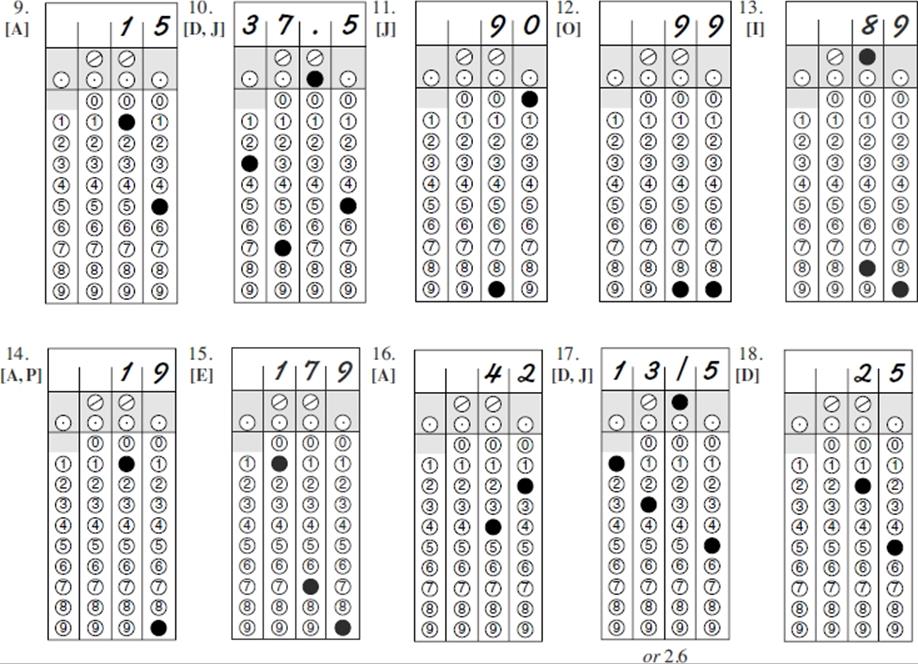
Section 8 Critical Reading
|
1. D 2. D 3. B 4. D 5. E 6. B 7. D |
8. C 9. B 10. A 11. E 12. D 13. C 14. B |
15. D 16. E 17. D 18. A 19. C |
Section 9 Mathematical Reasoning
|
1. B [G] 2. C [G] 3. C [D] 4. D [B] 5. B [E, G] 6. B [C, Q] |
7. C [K] 8. B [K, L] 9. E [P] 10. E [J, K] 11. D [E, G] 12. E [R] |
13. A [A] 14. B [R] 15. E [Q] 16. C [J] |
Section 10 Writing Skills
|
1. D 2. D 3. B 4. C 5. C |
6. D 7. E 8. C 9. C 10. D |
11. D 12. D 13. C 14. C |
Score Your Own SAT Essay
Use this table as you rate your performance on the essay-writing section of this Model Test. Circle the phrase that most accurately describes your work. Enter the numbers in the scoring chart below. Add the numbers together and divide by 6 to determine your total score. The higher your total score, the better you are likely to do on the essay section of the SAT.
Note that on the actual SAT two readers will rate your essay; your essay score will be the sum of their two ratings and could range from 12 (highest) to 2 (lowest). Also, they will grade your essay holistically, rating it on the basis of their overall impression of its effectiveness. They will not analyze it piece by piece, giving separate grades for grammar, vocabulary level, and so on. Therefore, you cannot expect the score you give yourself on this Model Test to predict your eventual score on the SAT with any great degree of accuracy. Use this scoring guide instead to help you assess your writing strengths and weaknesses, so that you can decide which areas to focus on as you prepare for the SAT.
Like most people, you may find it difficult to rate your own writing objectively. Ask a teacher or fellow student to score your essay as well. With his or her help you should gain added insights into writing your 25-minute essay.

|
Self-Scoring Chart |
Scoring Chart (Second Reader) |
||
|
For each of the following categories, rate the essay from 1 (lowest) to 6 (highest) |
For each of the following categories, rate the essay from 1 (lowest) to 6 (highest) |
||
|
Position on the Topic |
|
Position on the Topic |
|
|
Organization of Evidence |
|
Organization of Evidence |
|
|
Sentence Structure |
|
Sentence Structure |
|
|
Level of Vocabulary |
|
Level of vocabulary |
|
|
Grammar and Usage |
|
Grammar and Usage |
|
|
Overall Effect |
|
Over Effect |
|
|
TOTAL |
|
TOTAL |
|
|
(To get a score, divide the total by 6) |
|
(To get a score, divide the total by 6) |
|
Calculate Your Raw Score
Critical Reading
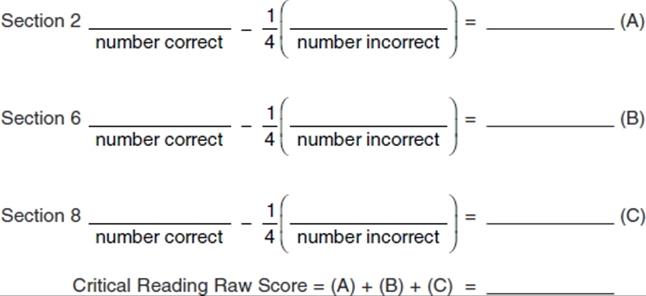
Mathematical Reasoning
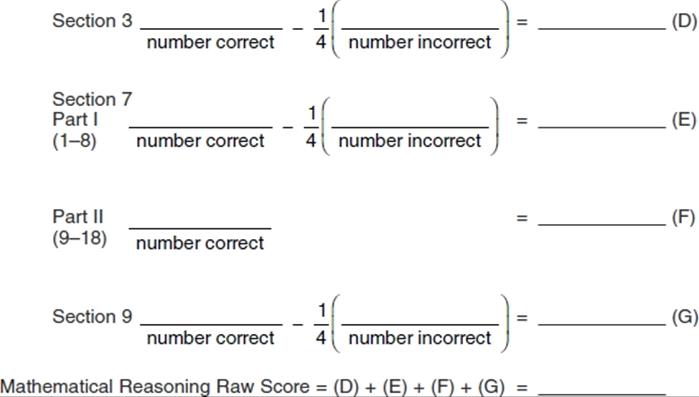
Writing Skills
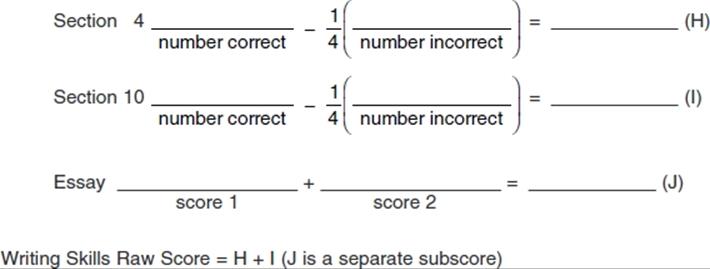
Evaluate Your Performance
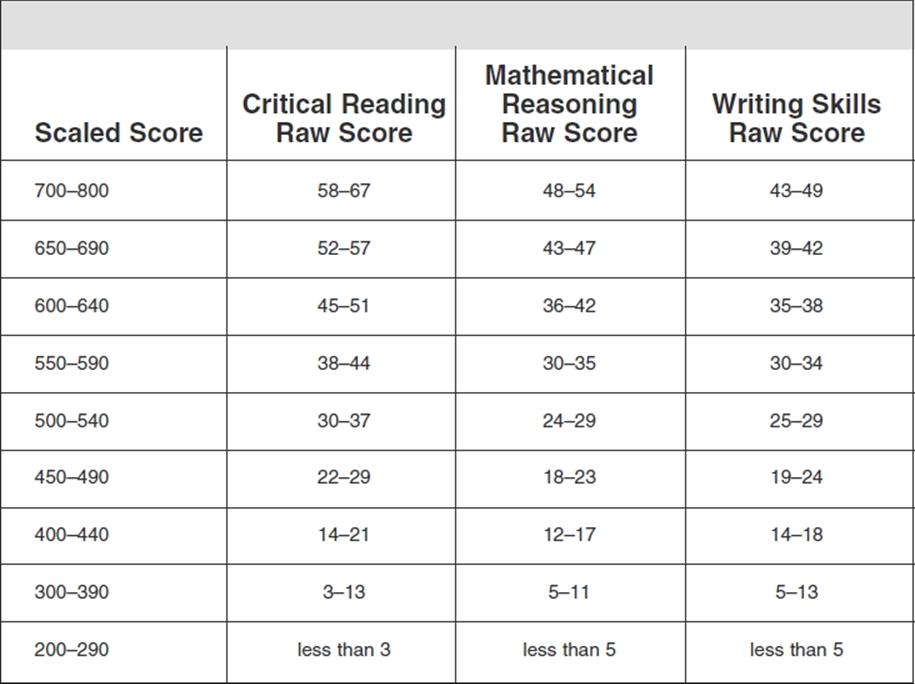
Identify Your Weaknesses
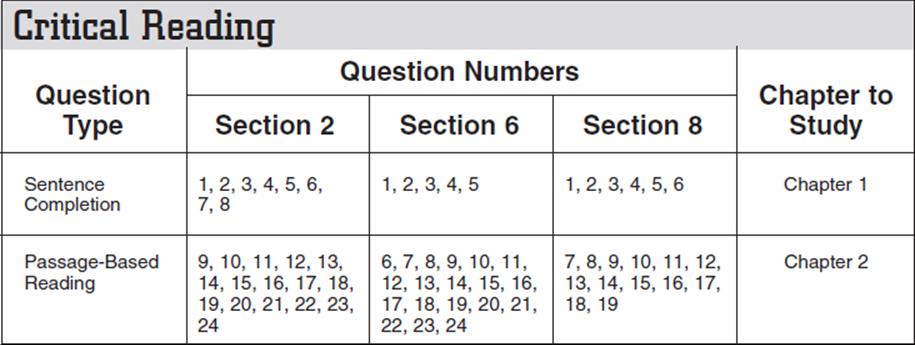
Identify Your Weaknesses
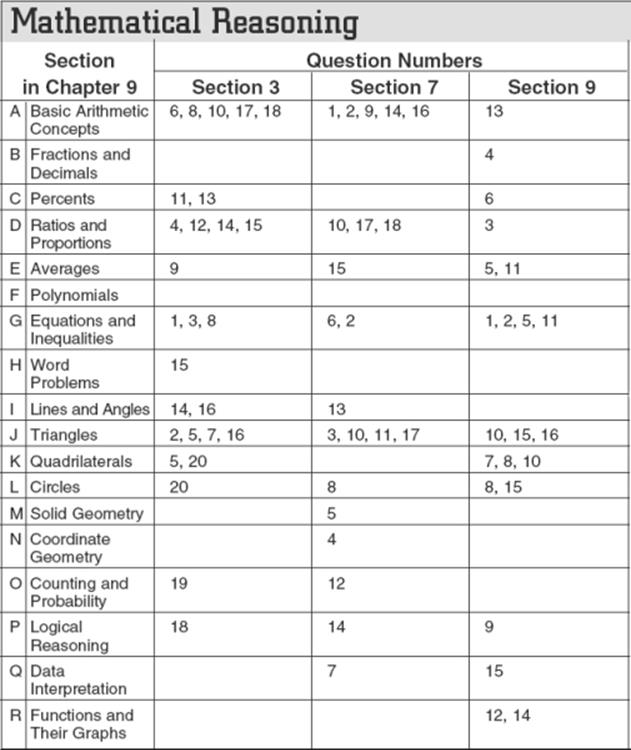
Identify Your Weaknesses
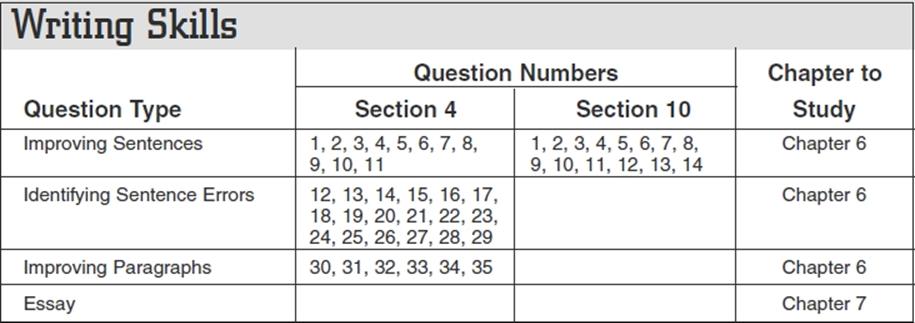
ANSWERS EXPLAINED
Section 2 Critical Reading
1. C. To uncover buried ruins is to excavate them. Notice the use of the comma to set off the phrase that defines the missing word.
(Definition)
2. D. Puritans (members of a religious group following a pure standard of morality) would be offended by lewd (lecherous, obscene) material and would fear it might corrupt theatergoers.
(Argument Pattern)
3. D. Rescind means to cancel or withdraw. The lawmakers were so angered by the governor’s enactment of martial law that they refused to work until it was canceled.
The phrase “the last straw” refers to the straw that broke the camel’s back. Because the governor had exceeded his bounds, the lawmakers essentially went on strike.
(Cause and Effect Pattern)
4. A. Malingering means pretending illness to avoid duty. Faced with an arduous (hard) march, a private might well try to get out of it.
(Argument Pattern)
5. A. What was once a minor problem is now a major cause of death; what was formerly negligible (insignificant; minor and thus of no consequence) has become the chief cause of cancer-related deaths. Note how the two phrases set off by commas (“formerly...”; “once...”) balance one another and are similar in meaning.
Remember: in double-blank sentences, go through the answer choices, testing the first word in each choice and eliminating the ones that don’t fit.
(Argument Pattern)
6. B. The columnist was almost reverential (worshipful) in what he wrote about those he liked, but he savagely attacked those he disliked. “Even” here serves as an intensifier.
Acrimonious (stinging or bitter in nature) is a stronger word than unpleasant. It emphasizes how very unpleasant the columnist could become.
(Contrast Signal)
7. A. Propitious means favorable. It would be sensible to wait for a favorable moment to reveal plans. Remember: before you look at the choices, read the sentence and think of a word that makes sense.
Likely Words: appropriate, fitting, favorable.
(Examples)
8. C. Metternich hires ships’ captains to buy books to add to his growing (burgeoning) collection. This is an example of his great passion for books (bibliomania).
Word Parts Clue: Biblio- means book; mania means passion or excessive enthusiasm.
(Example)
9. B. The coal-mining company naturally sought a court that it expected to be favorably inclined toward its case.
10. D. The author, alluding to the judges’ ruling that the damage had been an act of God, is being ironic in describing the coal operator as Godfearing or perhaps not so God-fearing after all. Certainly the coal operator does not fear God enough to recompense the people who suffered because of his actions.
11. C. Mr. Watson dislikes theatricality and violence in sermons. His notion of a proper preacher is one who avoids extremes in delivering his sermons.
12. A. Mr. Watson likes simplicity in preaching. Thus, he condemns artificiality and a studied or affected (phony, pretentious) attitude.
13. D. The sentence immediately preceding the De Voss quotation asserts that rock and roll is “big corporation business.” The De Voss quote is used to support this view that rock and roll is a major industry , for, by showing that many rock stars earn far more than major corporate executives do, it indicates the impact that the music business has on America’s economy.
14. C. Consumption here refers to using up [consumer] goods, such as foodstuffs, clothes, and cars.
15. A. The washing machine, spot cream, and rock band are all “on the market” (lines 28 and 29): they are all being marketed as commodities, and they all serve equally well to distract the consumer from more essential concerns.
16. C. “Plastic” here is being used metaphorically or figuratively. It creates an image of rock and roll as somehow synthetic, dehumanized, even mercenary, as in plastic smiles or plastic motel rooms or plastic money.
17. E. To Burchill and Parsons, the consumer is “a potential Moron” who can be kept quiet and content by being handed consumer goods as a distraction. Thus, the consumer is someone who is vulnerable to manipulation by the enemy.
18. B. Dylan is given credit for “introducing the explicit politics of folk music to rock and roll.” Clearly, this implies that, at the time Dylan introduced politics to rock, folk music was already an openly political medium through which artists expressed their convictions. It was only after Dylan’s introduction of political ideas into his lyrics that other rock and roll artists began to deal with political materials. In other words, folk music gave voice to political concerns long before rock and roll music did.
19. D. Wiener makes three points about Paul: he lacked political values (was apolitical), wrote highly successful nonpolitical songs (“Number One hits”), and managed to sleep soundly. Clearly, this suggests that John, who attempted to express his political values through his songs and as a result had difficulty putting out Number One hits, didn’t always sleep soundly. This in turn implies that, as an apolitical performer who had a relatively easy time turning out hits, Paul suffered less strain than John did.
20. C. The author describes Lennon’s apolitical “Starting Over” as one of his “biggest hits” (line 70). Similarly, she describes the highly personal Double Fantasy album as “bestselling” (line 83). Thus, she clearly offers them as examples of profitable successes lacking political content.
21. E. The artist’s task is to keep or preserve his political commitment without deluding himself about how much influence his songs will have.
Treat vocabulary-in-context questions as if they are sentence completion exercises. Always substitute each of the answer choices in place of the quoted word in the original sentence.
22. B. Greene asks how one can “possibly avoid being a part of the power relations that exist.” He feels trapped. The more popular his music is, the more his work is subject to misinterpretation, and the more he is involved in the power relations of the music industry. As a politically committed artist, he is frustrated because he cannot escape involvement in the very power relations he condemns.
23. C. Throughout the last paragraph, the author reiterates that the politically motivated artist, given the difficulty of his material, is lucky to gain any degree of popular success. She clearly attributes any such success to pure luck or good fortune.
24. C. The author states that the “rock and roll artist cannot cause political change” (lines 104 and 105). In other words, he has no direct, immediate effect on the political situation. However, he may be able to make an indirectcontribution to political change by influencing his audience and thus contributing to any change it makes.
Section 3 Mathematical Reasoning
In each mathematics section, for many problems, an alternative solution, indicated by two asterisks (**), follows the first solution. When this occurs, one of the solutions is the direct mathematical one and the other is based on one of the tactics discussed in Chapter 8 or 9.
1. D. 3x = 12 ![]() x = 4
x = 4 ![]() 5x = 20.
5x = 20.
2. B. The sum of the measures of the three angles in any triangle is 180° (KEY FACT J1), so 90 + 33 + x = 180 ![]() 123 + x =180
123 + x =180 ![]() x = 57.
x = 57.
3. D. Clearing the parentheses in the original equation gives 8 – 8 + m = 8, so m = 8. **Use TACTIC 5: backsolve. Replace m by 0, choice C: 8 – (8 – 0) = 8 – 8 = 0. This is too small; eliminate A, B, C. Let m = 8, choice D. It works!
4. B. Use TACTIC 7: pick an easy-to-use number. Since ![]() of the members are boys, assume there are 9 members, 5 of whom are boys. Then the other 4 are girls, and the ratio of girls to boys is 4 to 5, or
of the members are boys, assume there are 9 members, 5 of whom are boys. Then the other 4 are girls, and the ratio of girls to boys is 4 to 5, or ![]() .
.
5. B. Triangle EAB is a 45-45-90 triangle; so, by KEY FACT J8, AE = 4 and BE = 4 ![]() . Since BCDE is a square, each of its other sides is also equal to 4
. Since BCDE is a square, each of its other sides is also equal to 4 ![]() , so the perimeter is 4 + 4 + 4
, so the perimeter is 4 + 4 + 4![]() + 4
+ 4![]() + 4
+ 4 ![]() = 8 + 12
= 8 + 12![]()
![]()
**Use TACTIC 2: trust the diagram. BC is clearly longer than AB, which is 4, but not nearly twice as long. A good guess would be between 5 and 6. Then the perimeter is between 23 and 26. Now, use your calculator; to the nearest whole number, the five choices are: 20, 25, 31, 29, 32. Obviously, the right one is B.
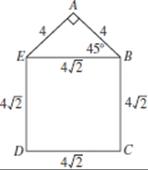
6. A. If x4 = 10, then (taking the square root of each side) x2 = ![]() , and x6 = x4 · x2 = 10
, and x6 = x4 · x2 = 10 ![]() .
.
**If x4 = 10, then x8 = x4 · x4 = 10 × 10 = 100, so x6 is surely less. Of the five choices, only A, 10![]() , is less than 100.
, is less than 100.
![]()
**Use your calculator. The fourth root of 10, (10.25), is approximately 1.78, which, when raised to the sixth power (1.786), is approximately 32. Only 10![]() is anywhere near 32.
is anywhere near 32.
7. E. Since by KEY FACT J2 the measure of an exterior angle of a triangle is equal to the sum of the measures of the two opposite interior angles, x = 80 + y. But, since BC > AC, by KEY FACT J3 y > 80. So, x must be greater than 160. Since x is an integer, it must be at least 161.
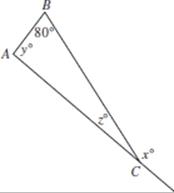
**Use TACTIC 5: backsolve. Start with 100, the smallest choice. If x = 100, then z = 80, which would leave only 20° for y. This is way too small, since y is supposed to be the largest angle. Try something much bigger for x.
8. B. Pick an integer, 2 say. Then
![]() = 2
= 2 ![]() a + 3 = 10
a + 3 = 10 ![]() a = 7,
a = 7,
and 5 goes into 7 once with a remainder of 2.
9. B. ![]() On six tests combined, Brigitte earned a total of 6 × 75 = 450 points (TACTIC E1). The total of her five best grades is 5 × 85 = 425 points, so her lowest grade was 450 – 425 = 25.
On six tests combined, Brigitte earned a total of 6 × 75 = 450 points (TACTIC E1). The total of her five best grades is 5 × 85 = 425 points, so her lowest grade was 450 – 425 = 25.
10. E. Check each statement independently.
• The only factors of 17 are ±1 and ±17. If m is any of these, ![]() is an odd integer. (I is false.)
is an odd integer. (I is false.)
• Could ![]() be an even integer? Sure, it could be any even integer; for example, if m = 34,
be an even integer? Sure, it could be any even integer; for example, if m = 34, ![]() = 2, and if m = 170,
= 2, and if m = 170, ![]() = 10. (II is true.)
= 10. (II is true.)
• Could 17m be a prime? Yes, if m = 1. (III is true.)
The true statements are II and III only.
11. C. The percent increase in Max’s investment is ![]() × 100%. Each share was originally worth $10, and the actual increase in value of each share was $10. Max’s percent increase in value =
× 100%. Each share was originally worth $10, and the actual increase in value of each share was $10. Max’s percent increase in value = ![]() × 100% = 100%.
× 100% = 100%.
12. C. The number, n, of reports Benjamin can type is equal to the rate, in reports per minute, at which he types times the number of minutes he types. Then n = ![]() × m minutes
× m minutes ![]() × m minutes =
× m minutes = ![]() reports.
reports.
![]()
**Use TACTIC 7: pick some easy-to-use numbers. Suppose Benjamin can type 1 report every 2 hours, and he types for 60 minutes; he will complete half of a report. Which of the five choices equals ![]() when h = 2 and m = 60? Only
when h = 2 and m = 60? Only ![]() .
.
13. B. ![]() The trust received 80% of the estate (10% went to the man’s wife, 5% to his children, and 5% to his grandchildren). If E represents the value of the estate, then
The trust received 80% of the estate (10% went to the man’s wife, 5% to his children, and 5% to his grandchildren). If E represents the value of the estate, then
0.80E = 1,000,000
E = 1,000,000 ÷ 0.80 = 1,250,000.
Each grandchild received 1% (one-fifth of 5%) of the estate, or $12,500.
14. E. Use TACTIC 1: draw a diagram. Since this is a ratio problem, immediatelyplug in a number (TACTIC 6). To avoid fractions, use 6, the LCM of the numbers in the question. Let AC = 6; then CD = 3, with D on either side of C. BD = 2, but B could be on either side of D, and so we have no way of knowing length BC. The value of the ratio ![]() cannot be determined from the information given.
cannot be determined from the information given.
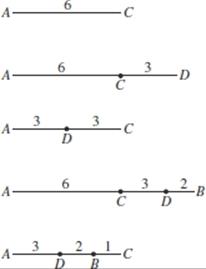
15. A. ![]() At 10:30 A.M. the first car had been going 40 miles per hour for 1.5 hours, and so had gone 40 × 1.5 = 60 miles. The second car covered the same 60 miles in 1 hour and 20 minutes, or
At 10:30 A.M. the first car had been going 40 miles per hour for 1.5 hours, and so had gone 40 × 1.5 = 60 miles. The second car covered the same 60 miles in 1 hour and 20 minutes, or ![]() hours. Therefore, its rate was
hours. Therefore, its rate was ![]() miles per hour.
miles per hour.
16. B. Since 5x = 360 (KEY FACT I3), x = 72 and m![]() AOB = 2x = 144. Since OA = OB (they are both radii),
AOB = 2x = 144. Since OA = OB (they are both radii), ![]() AOB is isosceles:
AOB is isosceles:
2y + 144 = 180 ![]() 2y = 36
2y = 36 ![]() y = 18.
y = 18.
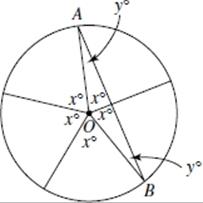
Then ![]()
**It should be clear that the values of x and y can be determined, so eliminate E, and use TACTIC 2: trust the diagram; x appears to be about 70 and y about 20. Then, ![]() and you should guess between
and you should guess between ![]() and
and ![]() .
.
17. D. It’s not hard to calculate ![]() and
and ![]() , but you don’t have to. Here,
, but you don’t have to. Here, ![]() –
– ![]() = (1 + 2 + ··· + 9 + 10) – (1 + 2 + ··· + 9 )= 10.
= (1 + 2 + ··· + 9 + 10) – (1 + 2 + ··· + 9 )= 10.
Now, calculate the choices: Only ![]() = 1 + 2 + 3 + 4 = 10.
= 1 + 2 + 3 + 4 = 10.
18. D. ![]()
![]() = (1 + 2 + ··· + 1000) + (1001 + 1002 + ··· + 1010). The sum in the first parentheses is just
= (1 + 2 + ··· + 1000) + (1001 + 1002 + ··· + 1010). The sum in the first parentheses is just ![]() = a. The sum in the second parentheses is (1000 + 1) + (1000 + 2) + ··· + (1000 +10), which can be written as (1000 + 1000 + ··· + 1000) + (1 + 2 + ··· + 10) = 10,000 + b. The total is
= a. The sum in the second parentheses is (1000 + 1) + (1000 + 2) + ··· + (1000 +10), which can be written as (1000 + 1000 + ··· + 1000) + (1 + 2 + ··· + 10) = 10,000 + b. The total is
a + 10,000 + b = a + b + 10,000.
19. C. Draw a Venn diagram and label each region.
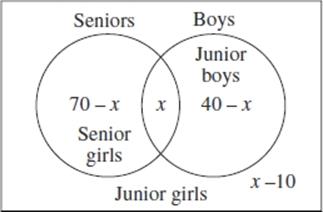
Let x be the number of senior boys. Then 40 – x is the number of boys who are not seniors (i.e., are juniors), and 70 – x is the number of seniors who are not boys (i.e., are girls).
Then number of junior girls
= 100 – [(40 – x) + x + (70 – x)] = 100 – [110 – x] = x – 10.
Since the number of junior girls must be at least 0, x – 10 ≥ 0 and so x ≥ 10.
**Use TACTIC 5: backsolve; but since you want the smallest number, start with A. If there are no senior boys, then all 40 boys are juniors and all 70 seniors are girls; but that’s 110 people. Eliminate A. If there are 5 senior boys, there will be 35 junior boys and 65 senior girls, a total of 105. Finally, check 10, which works.
20. C. Let r and R be the radii of the two circles. From the figure, you can see that ![]() OAB is a 45-45-90 right triangle, and so R = r
OAB is a 45-45-90 right triangle, and so R = r![]() (KEY FACT J8). Therefore,
(KEY FACT J8). Therefore,
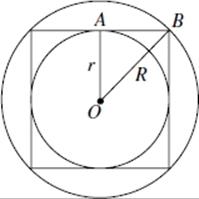
![]()
The ratio is 2:1.
**Do exactly the same thing except use
TACTIC 6. Let r = 1; then R = ![]() , and the ratio is
, and the ratio is ![]()
Section 4 Writing Skills
1. C. Error in sequence of tenses. This sentence illustrates the use of the future perfect tense. The present perfect tense, as used in Choice A, and the past perfect tense, as used in Choice B, are incorrect. Choice C correctly indicates that an anticipated event will be completed before a definite time in the future. Choice D is weak because of the use of the passive voice and the consequent vagueness as to who is performing the action. Choice E is awkward because of the needless separation of subject (we) from verb (shall have traveled).
2. D. Choices A, B, and C are examples of comma splice sentences. Choices B, C, and E also confuse the meanings of complementary and complimentary. Choice E leaves the verb is not without a subject. Choice D corrects the comma splice and adds no other errors.
3. E. Shift of personal pronoun. In Choices A and B there is an unwarranted shift from the third person pronoun one to the second person pronoun you. Choices C and D improperly use affect instead of effect.
4. D. Error in diction. Choices A and B illustrate the incorrect use of due to. The change to inasmuch in Choice C creates a sentence fragment. Choice E is poor because it omits the causal relationship implied by the original sentence.
5. B. Wordiness. Choice B cuts out the unnecessary words and creates a clear, effective sentence.
6. B. Error in logical comparison. Choices A, D, and E compare two things that cannot be directly compared—subways and cities. In Choice D, the omission of other changes the meaning of the sentence.
7. D. Choices A, B, and E omit important parts of the verb. Hopefully in Choices C and E is wrong; although many people use it this way, most grammarians do not accept it as a substitute for we hope. (Strictly speaking, hopefully should only be used to mean in a hopeful way, as in The farmer searched the skies hopefully looking for signs of rain.
8. B. Lack of parallelism. Change it partly pays tribute to part tribute.
9. A. Sentence is correct.
10. D. Run-on sentence. Choice D provides a replacement that is both grammatical and concise.
11. A. Sentence is correct.
12. D. Error in parallelism. Change the clause what his serial number was to a noun (serial number) to match the other items in the list.
13. D. Error in tense. Change will handle to handled.
14. B. Error in idiom. Change agreed with to agreed on. To agree with is to have the same ideas or feelings. I agree with you that grammar can be tricky. To agree on is to reach a settlement or come to terms. We agreed on a plan to raise money for our Girl Scout troop.
15. C. Error in subject-verb agreement. Dearth (lack) is a singular noun. Change have caused to has caused.
16. D. Error in pronoun number agreement. Since the antecedent of the pronoun is lawyers, change its to their.
17. B. Error in tense. Delete the word has to make the verb anticipated.
18. B. Error in pronoun number agreement. Everybody is a singular pronoun. Change their to his or her.
19. A. Error in logical comparison. Compare predicaments with predicaments, not predicaments with recording artists. Change like countless other to like that of countless other.
20. E. Sentence is correct.
21. B. Error in pronoun case. Change she and I to us.
22. A. Adjective and adverb confusion. The verb feels should be followed by an adjective (bad).
23. C. Error in verb form. Change will be sang to will be sung.
24. B. Error in pronoun case. Gerunds (verb forms ending in -ing that function as nouns) take the possessive pronoun. Change him joining to his joining.
25. D. Error in idiom. Change appointed of to appointed to.
26. C. Unidiomatic preposition choice. The verb evolve customarily is paired with the preposition from. Change evolved off to evolved from.
27. B. Lack of parallelism. Change what we wish to the plural noun wishes.
28. E. Sentence is correct.
29. B. Error in sequence of tenses. Change has labored to labored.
30. C. Choice A contains the extremely awkward phrase to see underdogs being the one rooted for. Choice Buses the coordinating conjunction but, which makes no sense in the context. It also contains the redundant phase “sight . . . to see.”
Choice C clearly and concisely combines the thoughts contained in the two sentences. It is the best answer. Choice D contains a clause and a phrase that have no grammatical relationship. Choice E contains a comma splice between Americans and for example.
31. C. All sentences except 3 contribute to the discussion of the underdog. Sentence 3 is an unnecessary digression. Therefore, Choice C is the best answer.
32. B. Choice A is grammatically correct, but it refers to Americans’ desire to feel good, a topic not discussed in paragraph 2. Choice B accurately introduces the topic of the paragraph. It is the best answer. Choices C and D are similar to A. Choice E is awkwardly expressed and contains the pronoun themselves, which refers grammatically to traditions instead of to Americans.
33. A. Choice A clearly and accurately combines the sentences. It is the best answer. Choice B is awkward and cumbersome. Choice C contains an awkward shift in verb tense from present (look) to past perfect (had been). Choice D contains the adverb poorly, which should be an adjective and should modify immigrants instead of coming.
34. C. Choice A is not an effective revision. It changes the focus of the discussion and contains the pronoun their, which refers grammatically to Americans instead of to underdog. Choice B contains an awkward shift in verb tense from past (believed) to present (succeed). Choice C follows naturally from the preceding sentence and is accurately expressed. It is the best answer. Choice D is grammatical, but it shifts the focus of the discussion. Choice E is confusing and containsthe pronouns they and their, which lack a specific referent.
35. D. Choice A contains some transitional material but shifts verb tenses from past (went) to present (defeat). Choice B, which lacks a main verb, is a sentence fragment. Choice C, although grammatically correct, seems incomplete because the pronoun it lacks a specific referent. Choice D provides a smooth transition between paragraphs and introduces the topic of paragraph 3. It is the best answer. Choice E lacks any meaningful transitional material.
Section 6 Critical Reading
1. E. The first clause states that the movement did not become famous instantly or “overnight.” Instead, it gained fame step by step, or gradually.
Remember to watch for signal words that link one part of the sentence to another. The use of “on the contrary” here sets up a contrast. The missing word must be an antonym for overnight.
(Contrast Signal)
2. E. The intensifier “even” indicates that Astell did more than merely maintain a good reputation; she improved or enhanced it.
(Intensifier Signal)
3. B. Kubota is hopeful about the success of the women’s movement. Thus, she maintains that the recent forward steps or strides made by Japanese women in business mean even greater chances for women in future days.
(Support Signal)
4. A. This is a case in which you can’t eliminate any of the answer choices by checking the first word of each answer pair: all are terms that could describe an ambassador. In this case, the eminent ambassador was only an indifferent (mediocre) linguist; nevertheless, he insisted on trying to speak foreign languages without help.
Remember to watch for signal words that link one part of the sentence to another. The use of “yet” in the second clause sets up a contrast.
Note that “but” here means “only.” That’s your clue to be on the lookout for a belittling or negative word.
(Contrast Signal)
5. B. To the author, nude models seem archaic, suited to an earlier day when art students spent as much time learning to draw the human body as medical students today spend learning to dissect or cut it up.
Remember: in double-blank sentences, go through the answer choices, testing the first word in each choice and eliminating the ones that don’t fit. By definition, a relic or remnant of a bygone age is outdated or old-fashioned.
You can immediately eliminate Choices C and E.
(Definition)
6. C. In stating that the voyageur struck his imagination, the narrator indicates that the voyageur impressed him.
7. D. Although the narrator comments on the voyageur’s strength and on the hardships and dangers he faces on the trail, the narrator is most impressed by the voyageur’s “unsurpassed nonchalance and joy in the wilderness.” To the narrator, this exuberance or zest is the voyageur’s outstanding quality.
8. C. Although both authors clearly appreciate the contribution of the voyageur to Canadian exploration and trade, the author of Passage 1 shows a greater degree of open admiration of the voyageur than does the author of Passage 2.
Beware of eye-catchers. While the author of Passage 1 may feel some degree of affection for the colorful voyageur, nothing in Passage 1 suggests that such affection may be misguided.
9. E. The author of Passage 1 describe the personal impression made upon him by the voyageur: “It was the voyageur who struck my imagination.”
Compared to the author of Passage 2, he writes personally rather than impersonally, making use of his personal voice.
10. E. You can arrive at the correct answer by the process of elimination.
Statement I is false. While sea action plays a part in erosion, the author does not say it is the most important factor in erosion. Therefore, you can eliminate Choices A and D.
Statement II is true. “The first purely synthetic oil . . . has yet to be produced.” Therefore, you can eliminate Choice C.
Statement III is true. New rock is born or created “through the effects of gravity.”
Therefore, you can eliminate Choice B.
Only Choice E is left. It is the correct answer.
11. B. The author mentions the Grand Canyon while speaking of rivers as “immensely powerful destructive agencies.” The dramatic canyon illustrates the devastating impact a river can have.
12. D. In the last paragraph the author states that “the cause of the metamorphosis” of decayed vegetation and dead aquatic life into oil is not known.
We lack full understanding of the process by which oil is created; therefore, our understanding is deficient.
Choice C is incorrect. Our knowledge is not erroneous or false; it is simply incomplete.
13. A. The last sentence states that oil is always found “on the sites of ancient seas and lakes.”
14. D. The author describes several processes (erosion, rock formation, oil formation). He states the possibility that a chemical catalyst is involved in oil formation. He cites the Grand Canyon as an example of what a river can do to the land. He mentions the limitation of our ability to produce oil synthetically. However, he never proposes a solution to any problem.
15. B. The term “reaches” here refers to the vast, unbroken stretches of time required for the mountains to erode and, out of their dust, for new rock to be formed at the bottom of the sea.
16. C. The author presents these favorable comments about myths in order to support his general thesis that myths and fairy tales perform valuable psychological and educational functions, that is, are valuable.
17. B. The author looks on contemporary parents who want their children exposed only to “real” people and everyday events as mistaken. Stating that Plato may have known more about what shapes people’s minds than these modern parents do, he suggests that his contemporaries may be misguided in their beliefs.
18. C. As used in this sentence, “make for” means help to promote or maintain. The author is asserting that Plato understood which sorts of experiences worked to promote the development of true humanity.
19. D. No matter what they originally believe—regardless of their original persuasion or opinion— contemporary theorists who study myths and fairy tales come to the same conclusion.
Remember: when answering a vocabulary-in context question, test each answer choice by substituting it in the sentence for the word in quotes.
20. C. The opening sentences of the second paragraph suggest that Eliade is a modern thinker who has studied myths from a philosophical or psychologicalview.
Note the use of the phrase “for one” in the sentence describing Eliade. “For one” indicates that Eliade is one of a group. In this case he is one example of the group of twentieth century philosophers who have explored the nature of myths.
21. E. The author has been discussing what there is about fairy tales that attracts and holds an audience’s interest. He concludes that their attraction or appeal is at one and the same time to our conscious mind and to our unconscious mind as well.
Again, when answering a vocabulary-in-context question, test each answer choice by substituting it in the sentence for the word in quotes.
22. D. Like Eliade and other modern thinkers, the author is concerned with the tales’ meeting strongly felt needs and providing desirable solutions to human problems—in other words, their psychological relevance.
23. E. The author’s citation of the favorable comments of Plato, Aristotle, and Eliade (and his lack of citation of any unfavorable comments) indicates his attitude is one of approval.
24. E. Use the process of elimination to answer this question.
Characteristic I illustrates a way in which fairy tales differ from dreams. Fairy tales are shaped by the conscious minds of many people (shared creation). Dreams, however, are created by an individual’s unconscious mind. Therefore, you can eliminate Choices B and D.
Characteristic II illustrates a second way in which fairy tales differ from dreams. Fairy tales promise a happy solution to problems (happy ending). Dreams, on the other hand, do not necessarily offer any solutions to problems.
Therefore, you can eliminate Choice A.
Characteristic III illustrates a third way in which fairy tales differ from dreams. Unlike dreams, which usually interest only the dreamer, fairy tales arouse persistent interest in many people (general appeal). Therefore, you can eliminate Choice C.
Only Choice E is left. It is the correct answer.
Section 7 Mathematical Reasoning
MULTIPLE-CHOICE QUESTIONS
1. B. ![]() Wally produces 80 widgets per day × 20 days per month × 12 months per year = 19,200 widgets per year; 96,000 ÷ 19,200 = 5.
Wally produces 80 widgets per day × 20 days per month × 12 months per year = 19,200 widgets per year; 96,000 ÷ 19,200 = 5.
2. E. If ![]() = 7, then either
= 7, then either
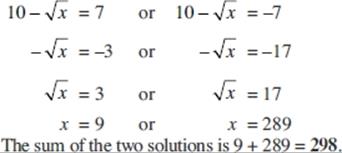
3. A. Since JL = KL, the angles opposite them have the same measure (KEY FACT J3). Then, d = a, and we can find the value of a (a + a + 70 = 180), but that’s it. Since b and e are not necessarily equal (see the diagram), we cannot determine b or c. The answer is a only.

4. E. O is the midpoint of AB. Let B have coordinates (x, y). Then by KEY FACT N3
(1,5) = ![]() . Therefore,
. Therefore,
1 = ![]()
![]() 2 = x + 5
2 = x + 5 ![]() x = –3, and
x = –3, and
5 = ![]()
![]() 10 = y + 1
10 = y + 1 ![]() y = 9.
y = 9.
Therefore, B has coordinates (–3, 9).
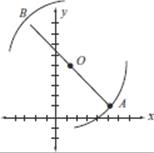
**Even a rough sketch will indicate that B is in Quadrant II, and y is surely greater than 5. Only choices D and E are even plausible. A good sketch will lead to choice E.
5. D. If the total surface area of the cube is 216, then the area of each of the 6 faces is 216 ÷ 6 = 36. Since each face is a square of area 36, each edge is 6. Finally, the volume of the cube is 63 = 216.
6. D. ![]() Let x be the amount, in dollars, that each of the 20 children was going to contribute; then 20x represents the cost of the present. When 4 children dropped out, the remaining 16 each had to pay (x + 1.50) dollars, so
Let x be the amount, in dollars, that each of the 20 children was going to contribute; then 20x represents the cost of the present. When 4 children dropped out, the remaining 16 each had to pay (x + 1.50) dollars, so
16(x + 1.5) = 20x ![]() 16x + 24 = 20x
16x + 24 = 20x ![]() 24 = 4x
24 = 4x ![]() x = 6,
x = 6,
and so the cost of the present was
20 × 6 = 120 dollars.
![]() **Use TACTIC 5: backsolve. Try choice C, 100. If the present cost $100, then each of the 20 children would have had to pay $5. When 4 dropped out, the remaining 16 would have had to pay $100 ÷ 16 = $6.25 apiece, an increase of $1.25. Since the actual increase was $1.50, the gift was more expensive. Eliminate A, B, and C. Try D, 120; it works.
**Use TACTIC 5: backsolve. Try choice C, 100. If the present cost $100, then each of the 20 children would have had to pay $5. When 4 dropped out, the remaining 16 would have had to pay $100 ÷ 16 = $6.25 apiece, an increase of $1.25. Since the actual increase was $1.50, the gift was more expensive. Eliminate A, B, and C. Try D, 120; it works.
7. C The function f(x) = ![]() is defined for all real numbers except those that cause x2 – 9 to be negative.
is defined for all real numbers except those that cause x2 – 9 to be negative.
x2 < 9 ![]() –3 < x < 3.
–3 < x < 3.
Five integers satisfy this inequality: –2, –1, 0, 1, 2.
8. E The area of the shaded ring is the area of the large circle, 25![]() , minus the area of the middle circle, 16
, minus the area of the middle circle, 16![]() :
:
Area of shaded ring = 25![]() – 16
– 16![]() = 9
= 9![]() .The probability that the point is in that
.The probability that the point is in that
ring is ![]()
GRID-IN QUESTIONS
9. (15) Evaluate 3a – 2b:
3(3) – 2(–3) = 3(3) + 2(3) = 9 + 6 = 15.
10. (37.5) ![]() Use TACTIC D1. In a ratio problem write the letter x after each number. Then, a = 6x, b = 7x, and c = 11x; and since the sum of the measures of the angles of a triangle is 180°:
Use TACTIC D1. In a ratio problem write the letter x after each number. Then, a = 6x, b = 7x, and c = 11x; and since the sum of the measures of the angles of a triangle is 180°:
6x + 7x + 11x = 180 ![]() 24x = 180
24x = 180 ![]() x = 7.5 . Then c – a = 11x – 6x = 5x = 5(7.5) = 37.5.
x = 7.5 . Then c – a = 11x – 6x = 5x = 5(7.5) = 37.5.
[Note that we did not have to find the value of any of the angles (TACTIC 10).]
11. (90) Draw a right triangle and label the two legs 15 and 36. To calculate the perimeter, you need only find the length of the hypotenuse and then add the lengths of the three sides. Before using the Pythagorean theorem, ask yourself whether this is a multiple of one of the basic right triangles you know: 3-4-5 or 5-12-13. It is: 15 = 3 × 5 and 36 = 3 × 12, so the hypotenuse is 3 × 13 = 39. The perimeter is 3(5 + 12 + 13) = 3 × 30 = 90.
![]()
![]() **If you don’t recognize the triangle, use the Pythagorean theorem and your calculator:
**If you don’t recognize the triangle, use the Pythagorean theorem and your calculator:
152 + 362 = c2 ![]() c2 = 225 + 1296 = 1521.
c2 = 225 + 1296 = 1521.
So c= ![]() = 39.
= 39.
The perimeter is 15 + 36 + 39 = 90
12. (99) From the 124 people in front of Jill, remove Jack plus the 24 people in front of Jack:
124 – 25 = 99.
**It may be easier for you to see this if you draw a diagram (TACTIC 1):

13. (89) Since y > x, then y must be greater than 90 and x less than 90. The largest integer less than 90 is 89.
14. (19) Draw a diagram. For the third-place share to be as large as possible, the fourth-place share must be as small as possible. However, it must be more than $15, so let it be $16. Then the amount, in dollars, left for second and third places is 100 – (30 + 16 +15) = 100 – 61 = 39. The second-place share could be $20, and the third-place share $19.

**Use TACTIC 7. Try a number. Third place must be less than 30 and more than 15; try 20. Then second place must be at least 21 and fourth place at least 16. But 30 + 21 + 20 + 16 + 15 = 102, which is a little too big. Try a little smaller number, such as 19, which works.
15. (179) If the average of a set of 9 numbers is 99, their sum is 9 × 99 = 891. If deleting 1 number reduces the average of the remaining 8 numbers to 89, the sum of those 8 numbers must be 8 × 89 = 712. The deleted number was 891 – 712 = 179.
16. (42) Use TACTIC 14. Systematically list all the ways of expressing 12 as the sum of three different positive integers, and calculate each product.
|
Integers |
Product |
Integers |
Product |
|
9, 2, 1 |
18 |
6, 5, 1 |
30 |
|
8, 3, 1 |
24 |
6, 4, 2 |
48 |
|
7, 4, 1 |
28 |
5, 4, 3 |
60 |
|
7, 3, 2 |
42 |
Then g = 60, ![]() = 18, and g –
= 18, and g – ![]() = 42.
= 42.
17. ![]() Use TACTIC 1.
Use TACTIC 1.
Draw a right triangle, and label the shorter leg a, the longer leg b, and the hypotenuse c.

Then ![]() =
= ![]()
![]() b =
b = ![]() Stop.
Stop.
This is a question about right triangles, so if the 12 and the 5 in that fraction make you think of a 5-12-13 triangle, check it out: ![]() = 3 and
= 3 and ![]() = 3. It works. The ratio is
= 3. It works. The ratio is ![]()
![]() **If you didn’t see that, use the Pythagorean theorem:
**If you didn’t see that, use the Pythagorean theorem:
c2 = a2 + ![]() =
=
a2 + ![]() a2 =
a2 = ![]() a2 +
a2 + ![]() a2 =
a2 = ![]() a2
a2![]()
c = ![]() =
= ![]() a
a ![]()
![]() =
= ![]()
18. (25) Since x varies inversely with y, there is a constant k such that xy = k. Then k = (3)(12) = 36, and, when x = 4, 4y = 36 ![]() y = 9. Also, since x varies directly with z, there is a constant m such that
y = 9. Also, since x varies directly with z, there is a constant m such that ![]() = m. Then m =
= m. Then m = ![]() , and when x = 4,
, and when x = 4, ![]()
![]() z = 16. Finally, 9 + 16 = 25.
z = 16. Finally, 9 + 16 = 25.
Section 8 Critical Reading
1. D. Buildings constructed in such a hurry would tend to be ramshackle (loosely held together) affairs.
(Definition)
2. D. Immune to most pesticides, cockroaches are thus tough or hardy and hard to eliminate.
Remember: in double-blank sentences, go through the answer choices, testing the first word in each choice and eliminating those that don’t fit. You can immediately eliminate Choices A and C.
(Cause and Effect Pattern)
3. B. Stoically means that a person bears pain with great courage.
Note how the part of the sentence after the comma describes the patient, and thus provides enough context to clarify how the patient bore or endured pain.
(Context Clue)
4. D. Note the use of “might.” Without the support of other stories, the actor’s stories might not be believed. If people need such supporting testimony, their first response to the stories must be disbelief. They must think them exaggerations or hyperbole. “Were there not” is a short way of saying “If there were not.”
(Argument)
5. E. Wemmick’s private kindness is contrasted with his public harshness. Note here the use of “even” as an intensifier: to be ruthless or relentless is more blameworthy than merely to be uncompassionate or hardhearted.
(Contrast Pattern)
6. B The view of Rome’s contributions to government, law, and engineering is wholly positive:
these additions to human knowledge are generally acknowledged. In contrast, Rome’s original contributions to art are not recognized: they are seen as just an echo or imitation of the art of ancient Greece.
Note that “although” sets up a contrast.
(Contrast Signal)
7. D. Wolfe is making a point through a simile, a type of figurative expression. Going home again, he says, is like stepping into a river, through which new water constantly flows.
Each time you step into the river, it will be different; each time you try to return home, it too will be different.
8. C. The author of Passage 1 states that at best the journey home will point you to your origins, “to where you started,” and will let you know how your origins have “helped to shape you.”
In other words, the most positive outcome of
your attempting to go home would be for you to grasp how your origins have formed you .
9. B. The author feels trapped between Wolfe’s certainty that one cannot go home again and Haley’s certainty that one can do so, that one can find the way back to one’s ancestral homeland and return to one’s roots. He is torn between extremes, uncertain about just what he is looking for—his conflicting desires clearly show his ambivalence about his journey.
Choice A is incorrect. The author has no desire to know what his ancestors looked like.
He is not seeking to convey his resemblance to them.
Choices C and D are incorrect. Nothing in the passage supports them.
Choice E is incorrect. Though on one level the author deeply desires to trace his roots (as Haley did), on another he feels attempting to do so is a meaningless exercise. Thus, he chiefly conveys his ambivalence about his journey.
10. A. A paradox is a seemingly contradictory statement that may perhaps be true in fact. Here the author was, in Africa, his ancestral homeland, but it did not feel like home to him. He clearly found his situation paradoxical.
11. E. Africa held or possessed symbolic significance for the author of this passage.
Remember: when answering a vocabulary-incontext question, try substituting each answer choice in the original sentence for the word in quotes.
12. D. Though the author earns his living as an arts administrator, he thinks of himself as a poet, a creative artist. When he says he needed time for his own work, he is referring to his creating poetry.
13. C. The author essentially looks down on his administrative work. Though it is timeconsuming, leaving him with little time to compose poetry, it is not a taxing or demanding job.
14. B. The author describes a scene in which he, a Japanese-American child watching old World War II movies, playacted being an American G.I. shooting down Japanese soldiers. Rather than siding with the Japanese soldiers whom he physically resembled, he took the part of their opponents. This episode serves to show how much he identified himself as an American.
Choice A is incorrect. The author had no particular hatred for Japan or the Japanese. He merely felt they did not have much to do with his life.
Choice C is incorrect. Though he has mentioned the fakery of Japanese films, he does not describe the American-made war movies in order to show that they are better than Japanese films.
Choice D is incorrect. Nothing in the passage supports it.
Choice E is incorrect. Childhood experiences playing soldiers would be unlikely to motivate anyone to travel to Japan.
15. D. Bali is in the South Pacific. The Bahamas are in the Caribbean. The primary thing these islands have in common is that they are classic exotic destinations for vacationers.
16. E. Like the author of Passage 1, the author of Passage 2 feels marked ambivalence about his prospective journey. He is happy to have won the fellowship, but unhappy at the prospect of having to spend a year in a country he finds relatively unappealing.
17. D. In the final lines of Passage 2, the author creates a picture of his imagination as a swimmer, “unconsciously swimming the Pacific” toward Japan, going against the tide of his family’s earlier movement from Japan to America. This picture is an extended metaphor or image.
18. A. In both passages, the authors are concerned about their racial or ethnic identity. The author of Passage 1 is seeking to discover “how much of being black” comes from his African origins. The author of Passage 2 has to a degree denied his ethnic identity (“Much of my life I had insisted on my Americanness, had shunned most connections with Japan and felt proud I knew no Japanese”) and yet has celebrated his Japanese heritage in his verse.
Choice B is incorrect. The authors are not seeking to establish their independence as individuals. They are seeking to discover the nature of their ties to their ancestral homelands.
Choice C is incorrect. While the authors may wish to learn more about their ancestors, they do not worship them.
Choice D is incorrect. There is nothing in either passage to support it.
Choice E is incorrect. While Passage 1 mentions Haley’s attempts to trace his roots, its author has no such attempts in mind. Passage 2’s author never mentions genealogical research.
19. C. Use the process of elimination to arrive at the correct answer to this question.
The author of Passage 2 insists that Japan “didn’t have much to do with” his present life.
This parallels the statement in Passage 1 that Africa held “only a symbolic significance” to the author. Therefore, Choice A is incorrect.
The author of Passage 2 asserts that he “had insisted on” his Americanness and “felt proud”
of knowing no Japanese. Like the author of Passage 1, who “did not feel African,” the Japanese-American author of Passage 2 did not feel Japanese. Therefore, Choice B is incorrect.
The author of Passage 2 states that his “reasons for going [to Japan] were not very clear.”
He hardly knew why he was going there. This parallels the comment in Passage 1 that its
author “hardly knew what” he was looking for in Africa. Therefore, Choice D is incorrect.
The image of “memories hidden in [one’s] genes” awakening in Passage 1 has its counterpartin Mura’s image of how his poetic imagination had been returning to his ancestral past, “unconsciously swimming the Pacific.”
Therefore, Choice E is incorrect.
Only Choice C is left. It is the correct answer.
Passage 1’s author is so torn between Africa and America that he comes to feel like a “waif withouta home.” There is nothing corresponding to this idea in Passage 2. Throughout Passage 2, its author insists on his Americanness, identifies with the GI’s in World War II movies. He clearly feels America is his home.
Section 9 Mathematical Reasoning
1. B. 3x = 36 ![]() x = 12
x = 12 ![]()
![]() = 4.
= 4.
2. C. If ![]() a =
a = ![]() b, then a = b, and
b, then a = b, and ![]() = 1.
= 1.
3. C. Set up a proportion:
![]() =
= ![]() Then
Then
2.2x = 120 ![]() x =
x = ![]() = 54.54...
= 54.54...
![]() Therefore, the 3 students weighing more than 120 pounds are the 3 who weigh more than 54.54 kilograms.
Therefore, the 3 students weighing more than 120 pounds are the 3 who weigh more than 54.54 kilograms.
**Quickly multiply by 2.2: 56 × 2.2 =123.2,
so 56, 57, and 61 kilograms are all more than 120 pounds. The other two weights are less.
4. D. Since the value of a share doubled every year, each year it was worth half as much as the following year. In 1990 a share was worth $80, so in 1989 it was worth half as much, or $40; in 1988 it was worth $20; and in 1987 it was worth $10.
**Use TACTIC 5: backsolve, starting with C, 1986. If a share was worth $10 in 1986, then it was worth $20 in 1987, $40 in 1988, $80 in 1989. That’s a year too soon. Start a year later—1987.
5. B. If a is the average of 10 and some other number, x, then
a = ![]()
![]() 2a = 10 + x
2a = 10 + x ![]() x = 2a – 10.
x = 2a – 10.
**Use TACTIC 6. Pick a number for a, say 5.
Since 5 is the average of 10 and 0, check the five choices to see which one equals 0 when a = 5. Only B: 2(5) – 10 = 0.
6. B. ![]() The percent increase in a quantity is
The percent increase in a quantity is
![]() × 100% (KEY FACT C5).
× 100% (KEY FACT C5).
For each year calculate the actual increase and divide. For example, in 2005 the increase was $100 (from $150 to $250), so the percent increase was ![]() . In 2006 the increase was $200 and the percent increase was
. In 2006 the increase was $200 and the percent increase was ![]() × 100% = 80%. Check the other choices; this is the greatest.
× 100% = 80%. Check the other choices; this is the greatest.
7. C. The interior of the star is a hexagon, a six-sided polygon. By KEY FACT K2, the sum of the six angles in a hexagon is (6 – 2)180 = 4(180) = 720.
![]() **Use TACTIC 2: trust the diagram. Since each of the six angles clearly measures more than 100° but less than 150°, the total is more than 600 but less than 900. Only 720 is in that range.
**Use TACTIC 2: trust the diagram. Since each of the six angles clearly measures more than 100° but less than 150°, the total is more than 600 but less than 900. Only 720 is in that range.
8. B. If each side of the square is ![]() , then its perimeter is 4
, then its perimeter is 4![]() . Since the circumference of the circle is equal to the perimeter of the square, C = 4
. Since the circumference of the circle is equal to the perimeter of the square, C = 4![]() . But C = 2
. But C = 2![]() r, and so 2
r, and so 2![]() r = 4
r = 4![]()
![]() r = 2.
r = 2.
9. E. ![]() Just calculate the first 5 terms: a1 = 1;
Just calculate the first 5 terms: a1 = 1;
a2 = 12 + 1 = 2; a3= 22 + 1 = 5;
a4= 52 + 1 = 26; a5= 262 + 1 = 677.
10. E. The perimeter, P, of ![]() BCD = BC + CD + BD.
BCD = BC + CD + BD.
Since BC + CD = 7 (it is one-half the perimeter of rectangle ABCD), P = 7 + BD.
But BD cannot be determined, since it depends on the length of sides BC and CD.
Both rectangles in the figure have perimeters that are 14, but the values of BD are different. The perimeter of ![]() BCD cannot be determined from the information given.
BCD cannot be determined from the information given.


11. D. If a represents Jordan’s average after five tests, then he has earned a total of 5a points (TACTIC E1). A grade of 70 on the sixth test will lower his average 4 points to a – 4.
Therefore
a – 4 = ![]()
![]() 6(a – 4) = 5a + 70. So,
6(a – 4) = 5a + 70. So,
6a – 24 = 5a + 70 ![]() 6a = 5a + 94
6a = 5a + 94 ![]() a = 94.
a = 94.
![]() **Use TACTIC 5: backsolve, starting with choice C, 90. If Jordan’s five-test average is 90, he has 450 points and a 70 on the sixth test will give him a total of 520 points, and an average of 520 ÷ 6 = 86.666. The 70 lowered his average 3.3333 points, which is not enough. Eliminate A, B, and C. Try D, 94.
**Use TACTIC 5: backsolve, starting with choice C, 90. If Jordan’s five-test average is 90, he has 450 points and a 70 on the sixth test will give him a total of 520 points, and an average of 520 ÷ 6 = 86.666. The 70 lowered his average 3.3333 points, which is not enough. Eliminate A, B, and C. Try D, 94.
It works.
12. E. g(–10) = f(3(–10)) = f(–30) = (–30)2 – 3(–30) = 900 – (–90) = 900 + 90 = 990
**g(x) = f(3x) = (3x)2 – 3(3x) = 9x2 – 9x.
Then g(–10) = 9(–10)2 – 9(–10) = 900 + 90 = 990.
13. A. 
![]()
14. B. The graph of y = f(x – 2) is obtained by shifting the graph of y = f(x) 2 units to the right.
Therefore the x-intercept (–3, 0) shifts 2 units to (–1, 0); the only x-coordinate is –1.
15. E. ![]() Store 2 sold 30 DVDs at $50, 40 DVDs at $80, and 20 DVDs at $120. Store 2: (30 × $50) + (40 × $80) + (20 × $120) = $7100.
Store 2 sold 30 DVDs at $50, 40 DVDs at $80, and 20 DVDs at $120. Store 2: (30 × $50) + (40 × $80) + (20 × $120) = $7100.
Store 1 sold 10 DVDs at $80, 20 DVDs at $100, and 20 DVDs at $150. Store 1: (10 × $80) + (20 × $100) + (20 × $150) = $5800.
Finally, $7100 – $5800 = $1300.
16. C. According to the triangle inequality (KEY FACT J10), the sum of the lengths of two sides of a triangle must be greater than the length of the third side. There is only one way to pick a number, a, from A and a number, b, from B so that their sum is greater than 7:
a = 3 and b = 5. There are three ways to choose a and b so that their sum is greater than 6: a = 2 and b = 5; a = 3 and b = 4; and a = 3 and b = 5. Therefore, in all there are 4 ways to pick the lengths of the three sides.
**List the 8 ways there are to choose one number from each set:

The four ways with check marks are the ones in which the sum of the two smaller numbers is greater than the third number.
Section 10 Writing Skills
1. D. Wordiness. Choice D makes the writer’s point simply and concisely.
2. D. Error in subject-verb agreement. Remember: the subject’s grammatical number is not changed by the addition of a phrase that begins with along with, together with, or a similar expression. The subject, princess, is singular. The verb should be singular as well. Only Choice D corrects the error without introducing fresh errors.
3. B. Lack of parallelism. Choice B tightens the original loose sentence, neatly linking its similar elements (the smallest and the most truculent) with the connective yet to produce a balanced sentence.
4. C. Lack of parallelism. Choice C balances the past tense verb took with a similar verb in the past tense (incorporated), linking them with the connective and.
5. C. Misplaced modifier. Who are away on leave? Not the rooms, but the students!
6. D. Error in logical comparison. Compare students with students, not students with a time period (“the middle of the twentieth century”).
7. E. Error in usage. A comedy duo by definition consists of two comedians.
8. C. Error in modification. Ask yourself who was writing the review. Was it the production? No, the production was being reviewed: the reviewer was the paper’s theater critic. Only Choice C rewrites the sentence so that the phrase Writing a review of opening night correctly modifies critic.
9. C. Dangling modifier. Who was afraid of meeting strangers? Obviously, Elizabeth Barrett. Choice C rearranges the sentence to eliminate the dangling modifier. (While choice E also rearranges the sentence so that the opening phrase modifies Barrett, it introduces a comma splice.)
10. D. Wordiness. Choice D eliminates the unnecessarywords for and they.
11. D. The suggested revision tightens this ineffective compound sentence in two ways: first, it eliminates the connective and; second, it repeats a landscape to emphasize its importance.
12. D. Error in logical comparison. Compare numbers with numbers, not numbers with minivans.
13. C. Double negative. Change could hardly do nothingto could hardly do anything.
14. C. Error in logical comparison. Compare cities with cities, not cities with mayors.